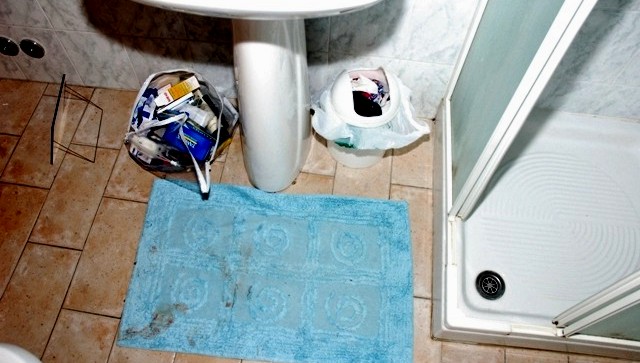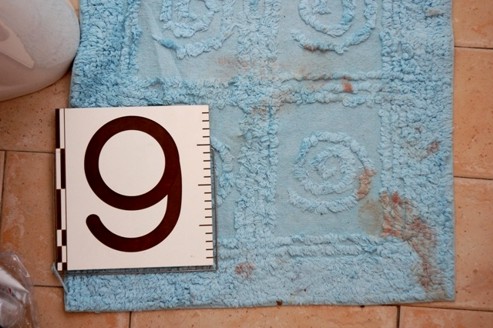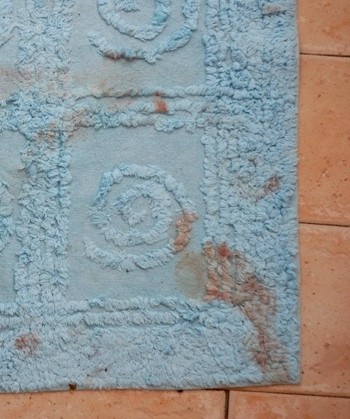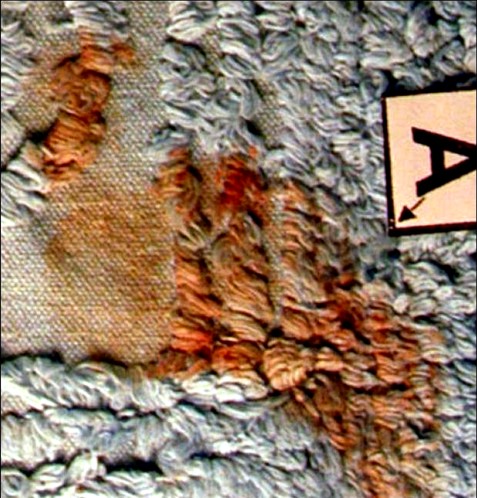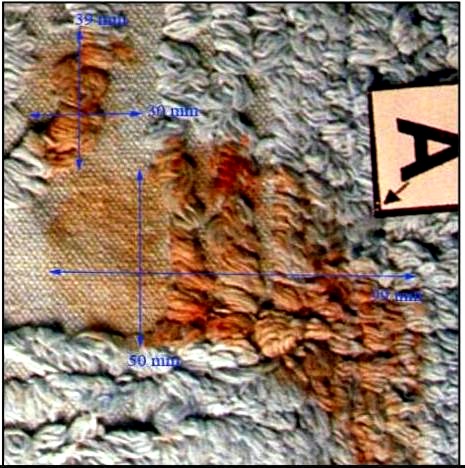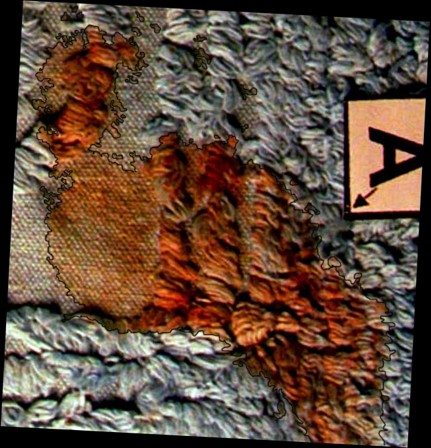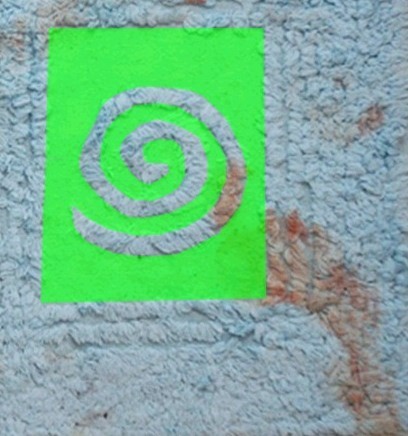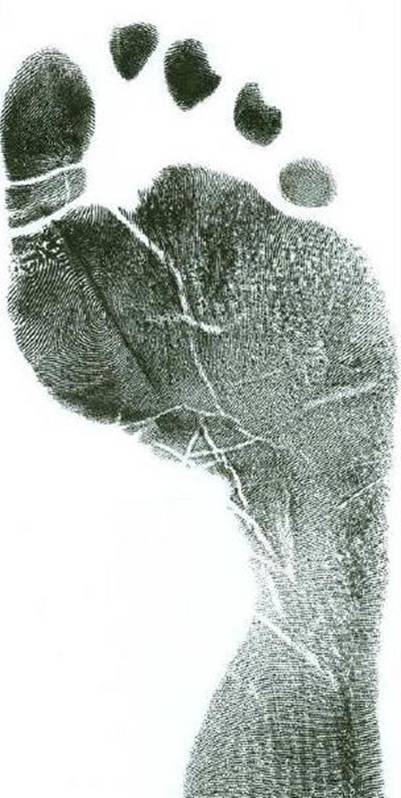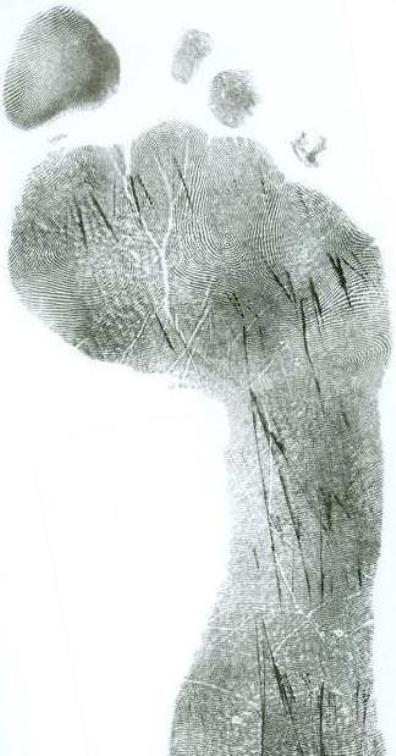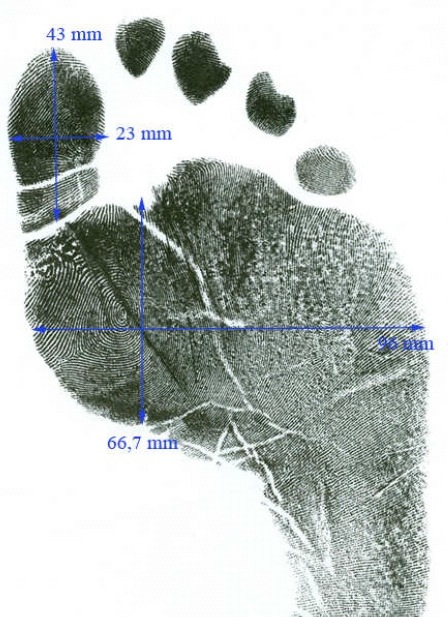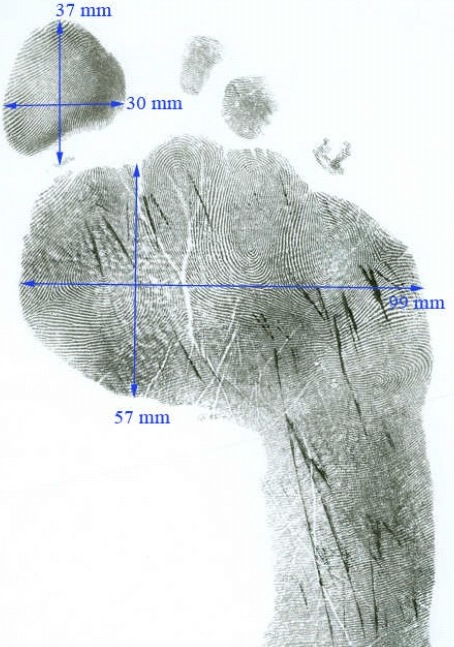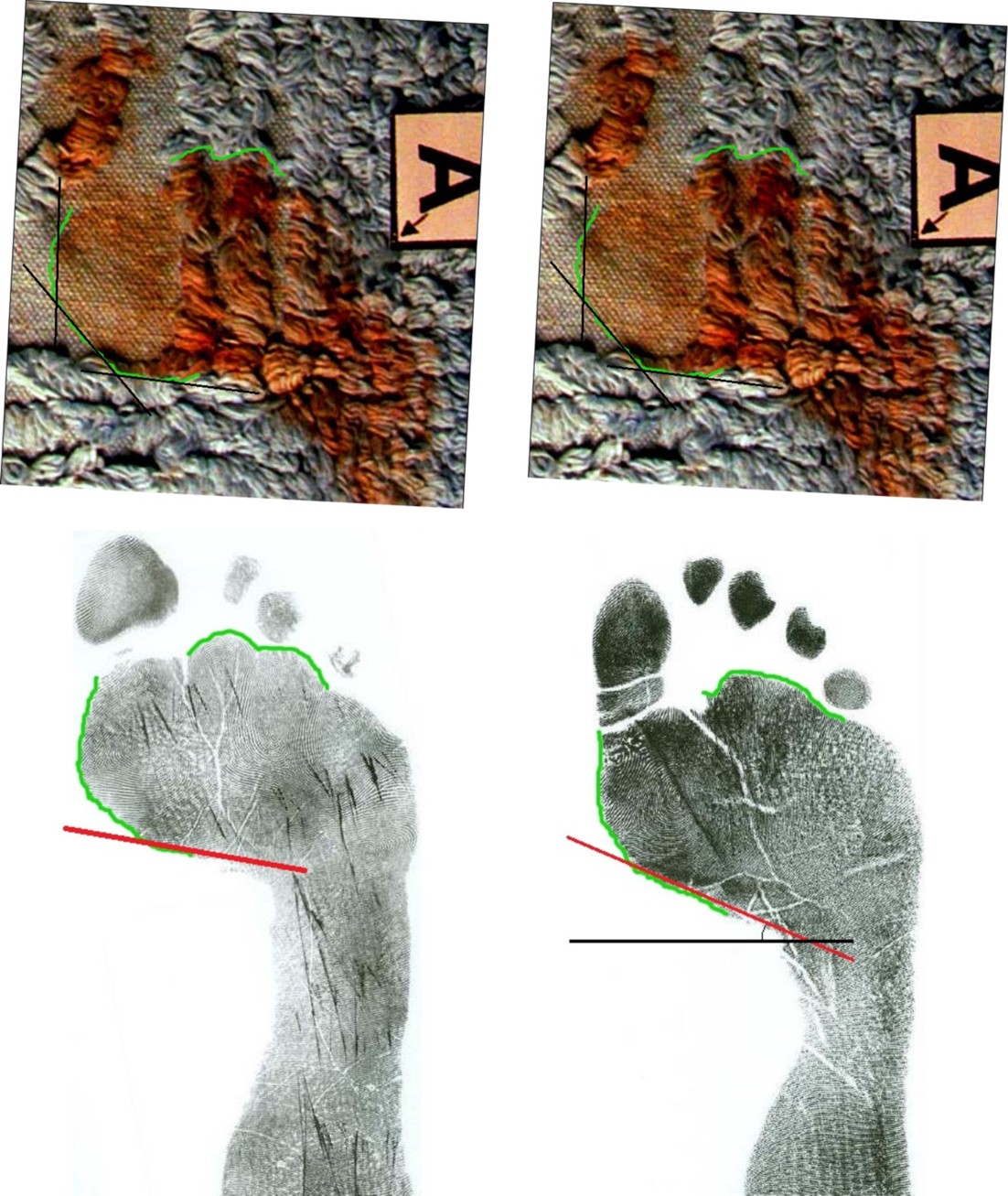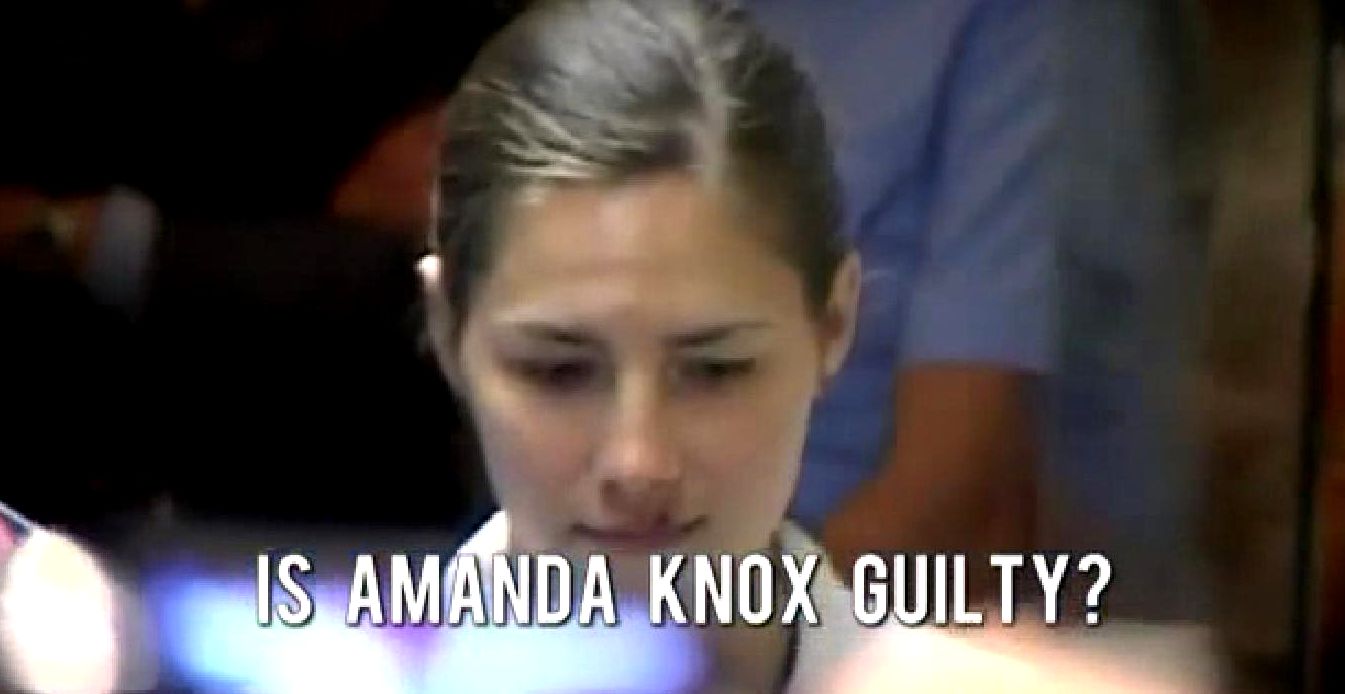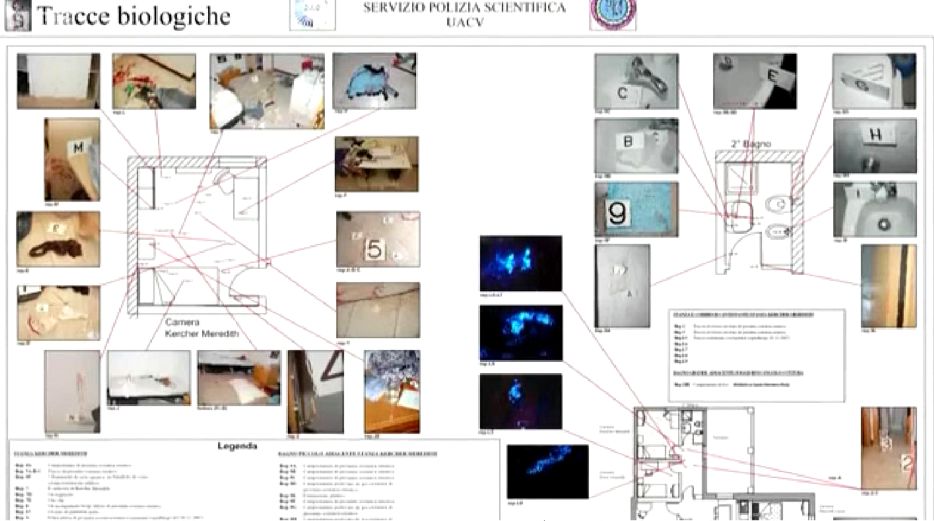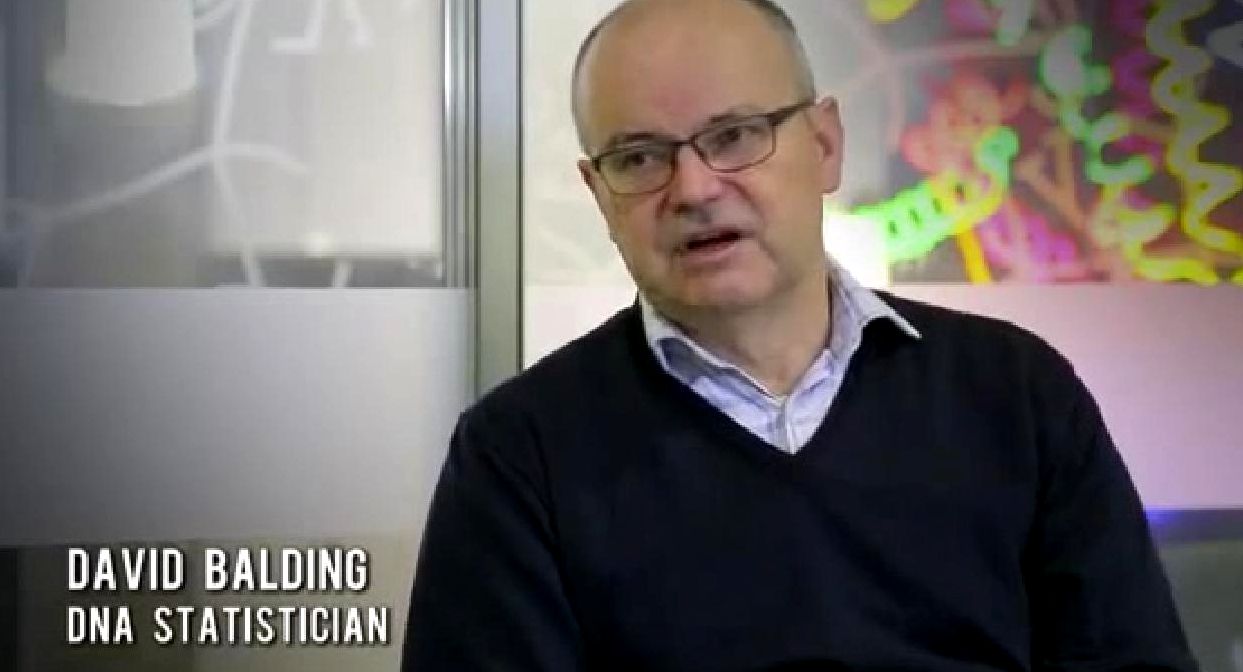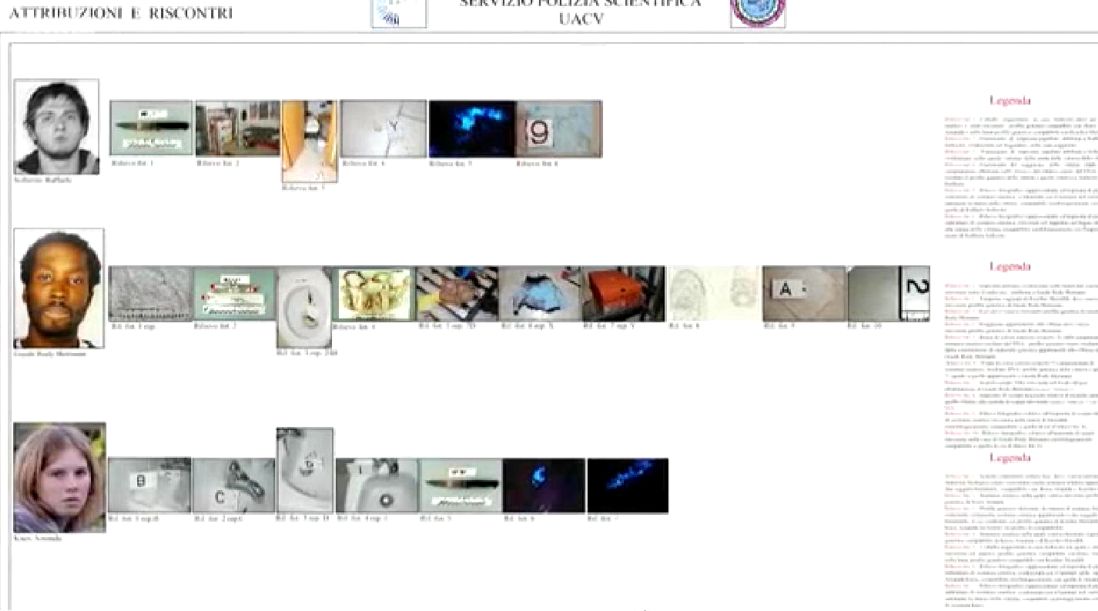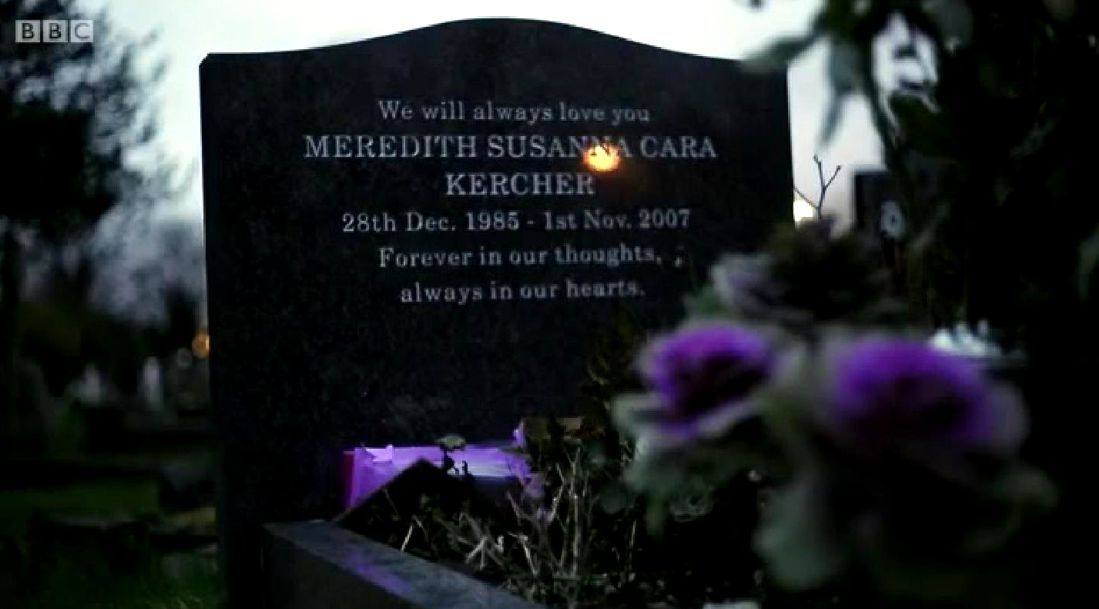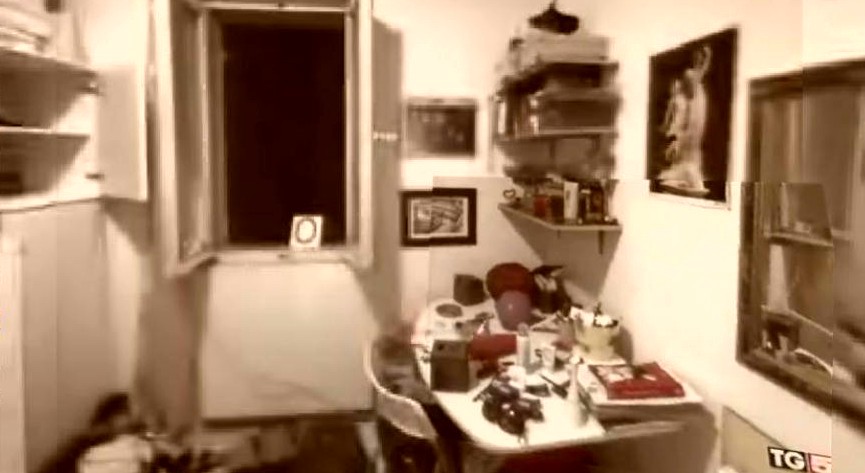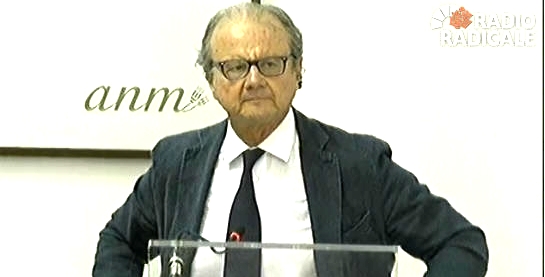
Category: Real crimescene
Sunday, February 15, 2015
Sollecito v Italy & Guede: My Subtitled YouTubes Of Rudy Guede’s Interview with Leosini
Posted by Eric Paroissien
Saturday, November 29, 2014
The PMF/TJMK Master Evidence List: First Of Our Projects To Make The Final Picture Whole
Posted by Our Main Posters
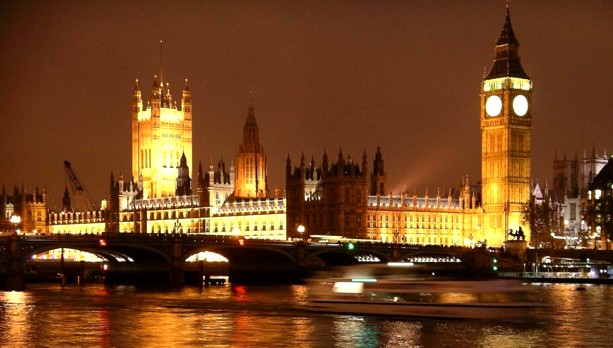
High-achiever Meredith Kercher was born less than one mile south of this famous London landmark
Building An Evidence Mountain
There are really three pictures, not just the one, still to be fully made whole.
- That of Meredith. We believe a family site will soon add to the fine book published by Meredith’s dad.
- That of all of the evidence the court acquired in 2009, which is the sole picture the Italian citizenry takes seriously.
- That of the misleading campaign by the Knox and Sollecito PR shills, leaving some in the UK and US misled.
The Master Evidence List is a key part of the second picture and there are several other media-friendly pages still to come.
Please click here for more
Monday, September 15, 2014
Analysis #1 Of Testimony Of Marco Chiacchiera, Director, Organized Crime Section, Flying Squad
Posted by Cardiol MD
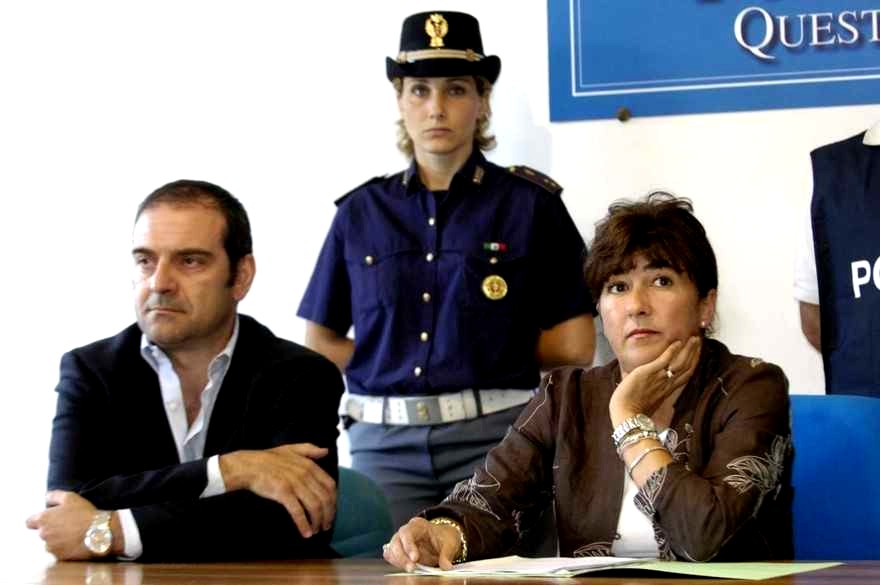
Dr Chiacchiera with Dr Comodi explaining reason for charges in another case
Overview Of This Series
Yet another vital translation which will be posted in the trial testimony areaof McCall’s great Wiki. This again is translated by the ever-dedicated main posterr ZiaK.
Although I graduated as a medical doctor I also graduated as a lawyer, and was often in courtrooms. For this post and the rest of the Chiacchiera series I am wearing my lawyer’s hat to point out what strikes me in Prosecutor Comodi’s questions, Marco Chiacchiera’s testimony, and the cross-examinations by defense lawyers.
Prior Preparations And Procedures
Under the Italian Code, before the beginning of the trial phase in Italy, the parties file a brief, detailing all evidence they want to present ““ the parties have to indicate by name every witness and precisely what these will be asked. The aims include creation of a Record of Admissible Facts.
Also under the Italian Code, both the defendant and the prosecutor can cross-examine each other’s witnesses. The Judge may choose not to admit any testimony that appears patently superfluous, reject irrelevant or improper or irregular questions ““ such as leading questions, and Inadmissible Hearsay ““ and also ask questions to the witnesses and experts.
Ground Covered In Dr Chiacchiera’s Testimony
- (1) He found Knox and Sollecito uncooperative when he asked them questions.
(2) Saw evidence contradicting any lone burglar theory and indicating that the “break-In” to Romanelli’s room was faked.
(3) Phone records and the police investigation into the accused phone activity the night of the murder.
(4) Discovery of pornographic magazines at Sollecito’s house.
(5) Details of how the large knife, Exhibit 36, was collected from Sollecito’s and the evidence that it is the murder knife.
My Assessment Of This Court Exchange
It is immediately obvious to me that this witness is a skilled witness; as such, and given his deep hands-on involvement in the immediate investigation this witness’s testimony is credible. My assessment therefore is that this was a very good and unflinching witness and that Dr Comodi shows no signs of leading the witness or seeking other than a truthful record.
I have seen prosecutors examine witnesses differently but dont believe the resultant record would have been superior. This would have stood up well in any American court.
(GCM=Giancarlo Massei; MC=Manuela Comodi; MaCh=Marco Chiacchiera; GB=Giulia Bongiorno; DD=Donatella Donati; CP=Carlo Pacelli; LG=Luciano Ghirga; CDV=Carlo Dalla Vedova; FM=Francesco Maresca)
Public Prosecutor Comodi [MC]
MC: Dr Chiacchiera, you carried out your duties where, when, at what moment of the events?
MaCh: I was and am the director of the Organized Crime Section of the Flying Squad and I am the vice-director of the Flying Squad. The Organized Crime Section is a branch of the Flying Squad that deals with “¦ the term, I think that in this place [i.e. the court] it is enough to say that it deals with organized crime. However, I am also the vice-director of the Flying Squad, for which [reason] I deal with, in the case of need, everything that is necessary [for] the various aspects.
{Witness supplies 5 items of relevant information that Examiner should elicit at beginning of examination.}
MC: Can you tell the Court how you became aware of events, who called you, when you became involved?
{Examiner asks another triple-question}
MaCh: Yes.
{Witness simply answers question as worded by Examiner}
MC: For now, start to tell us, then maybe I will intervene [NdT: i.e. interrupt with further questions] if necessary.
{Examiner, asking no Q, instructs witness, suggesting provisional forbearance if witness does not make interruptions necessary.}
MaCh: On the fateful day, at around 12:33, I had gone to the cemetery with my mother. The operations room called me immediately after the discovery of the body.
{Witness begins appropriate narrative response, but Examiner interrupts}
MC: So the 113? [NdT: 113 is the Italian State Police emergency number]
{Examiner interrupts witness with a Q, suggesting witness's receipt of call from an emergency number, but suggests wrong source-number}
MaCh: 110. The operations room of the Questura called me, and informed me of the happenings in an initially obviously very summarized manner. They said to me that there was a suspicious death, a young woman who lived in via della Pergola. I rushed to the place directly in my mother’s car. I didn’t stop by at the Questura, I didn’t go to get the service [i.e. police] car. I got myself taken to via della Pergola. We took about 15 minutes from the cemetery to there, ten fifteen minutes. In the meantime, I phoned the deputy Commissioner Napoleoni, in the temporary absence of the director, Dr Profazio, who arrived later, who was “¦ he was enjoying a period of leave, and with deputy Commissioner Napoleoni we arrived almost at the same time. We arrived almost simultaneously at the premises. Forensics, too, arrived almost at the same time at the premises.
{Witness supplies correct source-number and resumes interrupted narrative response}
MC: The Perugia Forensics?
{Examiner questions witness's correction, as if to verify and to ensure accuracy of court's record}
MaCh: The Perugia Forensics, I highlight, yes.
{Witness emphatically agrees with Examiner's question}
MC:”‹[They were] alerted by you, or ...?
{Examiner pauses mid-Q, inviting witness to guess complete Q, or is interrupted}
MaCh:”‹Alerted by the operations room, and also alerted by me.
,
{Witness responds to invitation, or interrupts with A to assumed complete Q}
MC:”‹So you arrive, and who do you find?
{Examiner's 1st simple Q.}
MaCh: “‹I found there ... there was already deputy Commissioner Napoleoni, there were also a few of Meredith’s co-tenants. There was Amanda Knox, there was Raffaele Sollecito. There were two young men who were, I believe, the friend of the boyfriend of one of the co-tenants. In short, there were a few people who had already been inside the house. There was the Postal Police.
{Witness answers Q in reasonable detail}
MC:”‹In the person of”¦?
{Examiner seeks more detail re specific Postal Police Personnel}
MaCh: “‹Battistelli and another of Battistelli’s colleagues. Inspector Battistelli, with whom there was immediately a discussion in order to understand what were the reasons for his intervention there, because it is not normal to find the Postal [police] in a crime of this sort. And he explained to me immediately what was the reason for his intervention. The origin of the, shall we way of his intervention, was due to the discovery of a pair of cellphones in a period of time, I believe, of an hour, [or] two, I don’t recall clearly, that were one in the name of one of Meredith’s co-tenants and one in the name of, later it [sic] “¦ I mean the SIM [card], obviously, the cellphones’ SIMs, the cards, they were in the name of a co-tenant and the other in Meredith’s [name]. The co-tenant, however, then told us, we then ascertained that both of the cellphones in fact were used by Meredith. And already that was, how shall we say, a first detail on which we began to reflect because, in fact, that was an element than in some way made us [become] immediately occupied/involved from an investigative point of view.
{Witness responds to Q and includes relevant amplifying narrative, anticipating probable future Qs re cellphones}
MC: “‹So, excuse me, also if the Court already, shall we say, knows this, because others have reported it, on this point however, where were the cellphones found?
{Examiner seems to interrupt with simple Q to clarify specific relevant fact not yet reached}
MaCh:”‹Inside the garden of a villa that is in via Sperandio.
{Witness responds appropriately}
MC:”‹In via Sperandio.
{Probably a Q, but implicitly inviting more specificity}
MaCh: “‹A villa that ... I am Perugian, [and] honestly, I didn’t even know there was a villa there. I’m Perugian, and I swear that I would have sworn [sic] that behind there was a wood.
{Witness flounders, seems unable to be more specific}
MC:”‹A field
{Probably a Q, but implicitly inviting more specificity}
MaCh: “‹It [was] the first time that I went in behind there. Instead, I see a marvelous old mansion with an enormous garden that gives ... that is almost adjacent to the street ““ the street that leads towards Ponte Rio. Anyone from Perugia understands me maybe.
{Witness seems to be in informal conversational mode}
MC: “‹From the structure of the fencing/enclosure, could you tell, shall we say, whether it was possible to throw these cellphones from the street, or whether it was necessary to enter the garden itself?
{Examiner engages witness, and asks Q to clarify how cellphones got into that garden}
MaCh: “‹Yes, obviously, we checked that. In fact, immediately, in short, the detail that seemed, how shall we say, of great investigative interest was that [very point], besides other details that I will go [into] a bit [sic], so to speak, also to give the impression of what the immediate impact was that we saw in the moment when we found ourselves in a situation of this type. So, deputy Napoleoni immediately entered inside the house in order to check it for herself. I did it [entered] shortly afterwards, also because [as] you will imagine that in that moment whoever was there had to notify all those who [sic], amongst whom Dr Mignini who was the Public Prosecutor on duty, and immediately give orders so that the correct checks are carried out. Because it was not just a crime scene that had to be analysed immediately: there also had to be, how shall we say, correlated with the information that we had got from via Sperandio ““ because the entry of the Postal [police in the case] originated with via Sperandio. And so we immediately asked ourselves: “Ah, what are these cellphones belonging to poor Meredith doing inside the garden of a villa?” And then And then immediately after, we asked ourselves, obviously, what might be the profile of the possible, or probable, murderer, and we discussed/talked about the crime scene. The crime scene immediately seemed fairly strange to us, if you wish [NdT: literally “if we wish” in Italian, but meaning the same as “shall we say”, “if you wish”, “so to speak” etc.]
{Witness responds to Q with detailed narrative}
MC:”‹Why?
{Examiner asks ambiguous Q, probably wrt crime scene seeming "fairly strange "}
MaCh:”‹Because the door did not show”¦ the entry door to the villa did not show signs of break-in. The we checked “¦
{Witness seems to decipher ambiguity correctly, begins narrative response, but is interrupted by Examiner}
MC:”‹We are not talking about the villa on via Sperandio obviously?
{Examiner interrupts with Q, apparently not comprehending Witness's narratives}
MaCh: “‹For the love of god! It was called a “villa” “¦ (overlap of voices), let’s say the house, of the house on via della Pergola there was no forcing/break-in. We found a forcing on the window. The window is this one, on the side of the house. I don’t know if you’ve seen the house? Anyhow, it is this one on the side of the house that can be seen immediately when you come down the slope from the gate. Logically reconstructing the thing, a hypothetical prowler [NdT: literally “ill-intentioned person”] who entered the house, breaking the glass with a rock - because inside the room, which was Romanelli’s room, which was the, shall we say, hypothetical arena of the entry, was completely in utter chaos. For that reason, what should we have hypothesized? That the hypothetical prowler took a rock, managed to throw the rock; the shutters, the external ones, the external shutters were not “¦
{Witness is exasperated at Examiner's apparent incomprehension, is repeating his previous testimony, but is interrupted by Examiner}
MC:”‹The dark-green wooden ones?
{Examiner interrupts with Leading Q re colour of external shutters. Now begins a confused and confusing colloquy. The arrangement of Filomena Romanelli's window, with Outside, and Inside Shutters, the Broken-Glass-Frame in-between, and the glass-splinters on the window-sill is complicated and needs a picture-exhibit that the witness can refer-to; this is apparently not provided, leading to the confusions}
MaCh:”‹The dark-green wooden ones were half shut, for which reason [he] must have had an aim like “Pecos Bill” [NdT: a cartoon Wild West cowboy], takes aim and throws that rock, smashes the window. After, he climbs up and does a turn on the little slope, and has to clamber up towards the window on the smooth surface, it seems to me, that from the ground up to the window there are two and a half metres-three [metres]. And then would have said: “bah, in short” [sic]. Yeah, well, the thing seemed to us…. in short, the first hypothesis that the investigator normally does, finds a level of unlikelihood of this kind of happening. After which, we looked at the house and we saw that an entry of a potential prowler [ill-intentioned person], still reasoning on the hypothesis”¦
{Witness amplifies narrative response but is interrupted by Examiner}
MC:”‹Of theft.
{Examiner inappropriately interrupts, incorrectly guessing what witness was about to say}
MaCh: “‹Of theft ending badly. Of theft that then degenerates because the burglar in some way thinks that he will find no-one in the house and instead finds a person, and then it degenerates “¦ We saw that there were easier means of entry, without wishing to bore you, but behind the house there was the possibility of climbing in a much easier way, without being seen by people that might have passed in the road. Let’s remember that, in short, it was not very late; quite the contrary. Normally people passed there, for which reason, if [he] had done it, the thing would probably have been seen. That thing there, as an hypothesis, we didn’t immediately discount it, that’s clear, because it’s a good rule to never discount any hypothesis. But we immediately considered that it was not a priority.
{Witness corrects Examiner's wrong guess, amplifies and seems to end narrative response}
MC:”‹Dr Chiacchiera, I interrupt you. (The witness is shown an exhibit.)
{Examiner, seems to acknowledge her habit of interruptions without actually interrupting, while introducing an unspecified exhibit. This introduction seems very informal, because Exhibits are normally identified by an assigned title.}
MaCh:”‹Ah! I didn’t remember it as being so big.
{Witness recognizes unspecified exhibit}
MC:”‹Precisely! You saw it? This is the rock that ...
{Examiner engages witness, stating it is "the rock".}
MaCh:”‹Yes, but it has been some time I have not, how shall we say, yes, I saw it. Absolutely.
However, it’s big, it’s huge.
{Witness engages Examiner, commenting on how large the rock exhibit is}
MC:”‹Do you consider that it could be this?
{Examiner ambiguously (what are "it" & "this "?) asks witness's opinion}
MaCh:”‹I believe so.
{Witness seems to overlook ambiguity of Q with vague A)
MC:"‹I try "¦
{Examiner begins to speak but is interrupted}
Judge Massei [GCM]:”‹How?
{Court interrupts as if to ask Q how Examiner 'tries'}
MC:”‹It is this. Yes, it is this one that was collected, yes, that was found.
{Witness seems to confirm that exhibited rock is the rock found in Filomena's room}
GCM:”‹So the rock is shown. [NdT: an “aside” for the court records?]
{Court formally announces admission of rock-exhibit, seemingly trying to reduce confusion caused by informal dialogue}
MaCh:”‹Inside the room where we then found the rock…
??:”‹But what was the question about the rock?
{Witness amplifies that rock had been found in a room, but enquires re rock Q, exposing confusion caused by informal dialogue}
GCM:”‹If this was the rock. And the witness said ...
{Court begins explanation to confused witness}
MaCh:”‹I said yes. Yes.
{Witness interrupts Court - confusion reigns}
GCM:”‹You saw it? You saw the rock?
{Court asks witness 2 Qs, trying to clarify that 'it' refers to 'the rock' that witness saw.}
MaCh:”‹Yes.
{Witness confirms that witness had previously seen the rock introduced into court as an unlisted exhibit.}
GCM:”‹When you saw it, where was it?
{Court proceeds to clarify confusion re where the rock was when witness originally saw the rock}
MaCh:”‹The rock [was] in the room of Romanelli.
{Witness specifically testifies, for witness's first time, that when witness originally saw the rock, the rock was in Filomena Romanelli's room}
GCM:”‹How far from the window? Can you say?
{Court continues to seek clarification using double-Q.}
MaCh: “‹A few centimetres [NdT: “un palmo” = “a hand’s width”] from the window sill, under the window, from the wall where the window is.
{Witness testifies clearly in answer to Court's 1st Q of above double-Q.}
GCM:”‹So from the internal perimeter wall, from where the window gives onto it, a “hand’s breadth”. So 20 centimetres…
{Court apparently begins to seek verification of witness's testimony, but is interrupted}
MaCh:”‹Mr President ....
{Witness begins to Interrupt Court}
GCM:”‹... away from it approximately.
{Court finishes his interrupted statement}
MaCh:”‹Yes.
{Witness agrees with Court's completed statement}
GCM:”‹And this is the rock. You remember it.
{Court states his understanding in form of Qs.}
MaCh:”‹Yes, yes, yes, yes. That is the rock.
{Witness impatiently agrees with Court's understanding}
MC:”‹At least as far as size and colour [are concerned], it corresponds thus to the one that was collected [as evidence].
{Examiner makes statements in form of Q, seeking verification of resemblance of exhibit-rock to original rock}
MaCh:”‹At least as far as size and colour [are concerned], it absolutely corresponds. If it was collected, I think that ...
{Witness begins narrative agreement with statements of Examiner, but is apparently interrupted by Examiner}
MC: “‹Very well. WITNESS [sic? Should be MaCh?] and Romanelli’s room was a complete shambles. The clothes were on the floor, the glass was strangely on top of the clothes, the [glass] shards were strangely on top of the “¦ on the windowsill, let’s put it that way.
{Apparent Transcriptional confusion attributing to interrupted witness narrative the interrupting .statement of Examiner}
MC:”‹The outside one.
{Examiner seems to amplify statement of Examiner wrt which window-shutter witness had been referring-to}
MaCh: “‹The outside one, precisely. The one that is between the shutters and the shutters [sic. NdT: “imposte” in Italian, but this can also mean shutters, or flap, as in the inner “scuri” shutters, or he may mean the window-frame itself, with the window-panes, given his following description], the green shutters and the shutters, the broken ones in short, where the glass is. The shutters ““ the wooden ones. The rock was a bit too close with regard to the wall if I [were to] throw it from least two metres. Unless it was lobbed [i.e. thrown in a high arc]. But in that case it’s rather unlikely that it would smash the glass. For that reason, I repeat, in the context of immediate likelihood, this one “¦
{Witness agrees with Examiner that he was referring to "The outside one", continuing with narrative of reasoning, but is interrupted by Examiner…}
MC:”‹Yes, it’s true. These are considerations. However they are considerations, shall we say, that refer [sic], because they are reasoning/lines of thought that are formed in the “immediacy” of the events [NdT: i.e. “in the immediate aftermath”. NOTE: throughout the text, a number of speakers use “immediatezza” (lit. “immediacy”) to convey a number of meanings, from “in the immediate aftermath”, or “in the immediate surroundings”, or “very soon after”, etc. I will translate them appropriately according to the context, without further explanation of the use of “immediatezza”], in order to proceed in one direction rather than another.
{Examiner, interrupting witness, apparently agreeing with witness's reasoning. While Examiner is apparently stating his own argumentative reservations re the possible evolution-in-time of witness's changing lines of reasoning, he is interrupted by Giulia Bongiorno, Sollecito defense lawyer:}
Giulia Bongiorno [GB]: “‹I never like to interrupt an examination [of a witness], however if one wanted, between the Public Prosecutor’s hypotheses, to do that [sic] of demonstrating that from a ballistic point of view it is not possible, then the ballistic expert should be called.
{GB interrupts Examiner to comment that Witness and Examiner are expressing opinions on Ballistics that require the testimony of a Ballistic Expert.}
MC:”‹But in fact, his considerations are not the considerations of an expert: they are the considerations of an investigator who made certain deductions in the immediacy of the events.
{Examiner argues that witness's testimony is that of an investigator's temporal train of thought.}
MaCh:”‹It happens to us too, at times, to reason/think rationally “¦
{Witness joins colloquy, amplifying Examiner's argument.}
GCM:”‹These reasonings/deductions, then determined your investigative activity in one direction rather than in an “¦?
{Court seems to invite further amplification by witness}
MaCh: “‹Yes, obviously, Mr President. I was trying to ... (overlap of voices) it is a premiss/basis to be able to then, how shall we say, reach ““ I won’t say conclusions ““ but in order to try to understand what our way of broaching the thing was, there and then. We had, I reassert, reasoned immediately also on via Sperandio. So the first thing, I may say, [was] the unlikelihood, or at any rate it was not the top priority hypothesis, the one of a prowler/ill-intentioned person entering. The open door without signs of break-in. But above all, a young woman who is [sic] probably killed in her own room, nude or almost nude, with a wound of that type, in a lake of blood, covered with a duvet. I repeat, the door was not smashed/wrecked, there’s a broken “¦ a window broken with a thrown rock, how can I say, it’s obvious that we immediately found this situation as “¦ (overlap of voices).
MaCh:”‹”¦ particular.
{Witness further amplifies narrative}
GCM:”‹You formed these considerations, and what did they lead you to?
{Court asks simple Q.}
MaCh: “‹That very probably the author or authors knew the person, or at any rate that the author or authors did not enter “¦ did not enter from the window-pane of that window.
{Witness responds with his conclusion that the authors of the faked break-in did not enter from the window-pane of that window.}
GCM: “‹Excuse me a moment, just to give some guidelines, but of the evaluations that the witness is expressing, obviously it’s not that they can be taken account of, however we will acquire them [for the trial files] in order to understand the investigation activities, the appropriateness of the investigations that were carried out, directed in one way or in another, there you go. However, maybe, “¦ there you go, yes, maybe if we can manage to keep with the bare essentials this will help everybody.
{Court proceedings seem to have been diverted into a free-for-all colloquy, with multiple participants chiming-in, and creating confusion. Court-President, GCM, now politely intervenes, apparently trying to restore order, ruling that the professional evaluations made by the witness, testified-to by the witness, should be admitted for the trial files. The appropriateness of the witness's evaluations can be dealt with separately and later.}
_________________________________________________
This segment of Chiacchiera’s Testimony re the Crime Scene, which he believed had been remodeled by the criminals to dupe Investigators into believing that there had been a burglary, committed by a single criminal, is paused here because it is so prolonged.
Analysis of Chiacchiera’s Testimony will continue in a future post.
Thursday, May 29, 2014
Ted “There Is No Evidence” Simon’s Tired Mantra Misinforms Americans And Provokes Italian Hard Line
Posted by Our Main Posters
No-evidence claim March 2013 contradicts tough-evidence claim Dec 2008
1. Is Ted Simon already fired?
Has Ted Simon been kicked off the Knox-Mellas team?
Ted Simon gets no mention on Knox’s website among the credits to her Italian legal and Seattle PR teams. He seems to serve zero useful purpose to anyone that we can see.
One could train a parrot to repeat “there is no evidence” for a smaller fee.
Ted Simon is certainly not helping Knox to get back to Planet Earth - in January Judge Nencini awarded her another year inside, and for continuing legal incautions Knox could certainly face more time.
As he seems utterly ineffective on all fronts, maybe it was high time that Ted Simon was gone.
2. If so five good reasons why
A year ago, he seemingly allowed (1) this false felony charge to be included in Knox’s book.
That malicious claim could result in more prison time for Knox, and maybe even open Ted Simon to a malpractice suit, for zero due diligence done on Knox’s book. Since then, Amanda Knox has shot herself in the foot four more times, at least, with no obvious legal restraint.
Knox charged ahead with (2) the insulting and inaccurate email to Judge Nencini, (3) the insulting and inaccurate appeal to the European Court of Human Rights, (3) the insulting and inaccurate first response to the Nencini Report, and the insulting and inaccurate website that Knox runs.
3. Seven more good reasons why
Our interest is for justice for Meredith and her family, for Italian justice to be seen in a fair light, and for an end to this protracted PR-driven dead-end fight, in which Ted Simon has had some hand.
So let us look at some other ways in which Ted Simon’s lazy mantra, a substitute for a convincing alternative scenario of the crime, gives, or at least gave, Amanda Knox false hopes and will ultimately let her down.
1. Take a look at this absurd claim by Ted Simon which millions of Americans now, large numbers of lawyers, and many TV hosts can laugh off as simply untrue.
“There was no hair, fiber, footprint, shoe print, handprint, palm print, fingerprint, sweat, saliva, DNA of Amanda Knox in the room where Meredith Kercher was killed,” attorney Theodore Simon told TODAY’s Savannah Guthrie. “That in and of itself tells you unassailably that she is innocent.” (CNN)
What exactly does that mean? Does Ted Simon even understand the scenario of the attack? This was a KNIFE attack, which does not usually see the exchange of a lot of DNA. There was the indisputable use of two knives in the attack - and Knox’s DNA is absolutely incontrovertibly on one.
Why does Ted Simon make no mention of that?
2. Meredith’s room was not fully swabbed for DNA because fingerprint dusting was the investigators’ (right) first choice. There were no fingerprints there - but there were none in Knox’s room either. Was she never there too? Knox’s lamp was found in Meredith room, with no prints. It would not have got there without help from her. There was a Knox-size shoeprint in the room. It would not have got there without help from her.
Why does Ted Simon make no mention of that?
3. Throughout the rest of the real crime-scene, which Ted Simon would really, really like Americans to forget includes a corridor, two bedrooms, and two bathrooms as well as Meredith’s room, there is stacks of unshaken forensic evidence against Knox. Indisputably a partial cleanup occurred because some footprints in several chains had been disappeared.
Why does Ted Simon make no mention of that?
4. There is, if anything, a surfeit of possible motives (not that there is a requirement for certainty there), and certainly there is a surfeit of alibis. Knox clearly framed Patrick. She was totally unprovoked by police, and yet even after three years actually served for felony framing, she continues to perpetrate the great hoax that she was.
Why does Ted Simon make no mention of that?
5. Amanda Knox is ever more frantically claiming that Rudy Guede carried out the crime against Meredith alone, and yet there is zero question of that. Many myths spread about Guede are untrue.
Why does Ted Simon make no mention of that?
6. Raffaele Sollecito was absolutely incontrovertibly in the apartment during the attack - his own lawyers have failed to prove the print on the mat was not his. Absent Knox, it is inconceivable that Sollecito was there.
Why does Ted Simon make no mention of that?
7. Finally dozens of lawyers are saying that the extradition treaty with Italy is crystal clear. If due process to a conviction was followed - and the American Embassy in Rome monitored it and saw nothing wrong - Knox could be on a plane within weeks to pay for what was a very cruel crime.
Why does Ted Simon make no mention of that?
4. Free! New Ted Simon mantras
Due to sudden problems with Ted Simon’s gibberish machine, we are happy to step up and provide these for free.
There was no hair, fiber, footprint, shoe print, handprint, palm print, fingerprint, sweat, saliva, DNA of Rudy Guede in the bathroom where there was a bloody footprint of RS and DNA of Knox,” attorney Theodore Simon told TODAY’s Savannah Guthrie. “That in and of itself tells you unassailably that Guede did not do the crime alone.”
There was no hair, fiber, footprint, shoe print, handprint, palm print, fingerprint, sweat, saliva, DNA of Rudy Guede in Filomena’s room where the breakin was staged, though there was Knox’s DNA” attorney Theodore Simon told TODAY’s Savannah Guthrie. “That in and of itself tells you unassailably that Amanda Knox is framing him.”
There was no hair, fiber, footprint, shoe print, handprint, palm print, fingerprint, sweat, saliva, DNA of Amanda Knox in the bedroom where she slept,” attorney Theodore Simon told TODAY’s Savannah Guthrie. “That in and of itself tells you unassailably that Knox did not even live in the flat.”
Look for them soon, on your local TV.
Wednesday, April 16, 2014
The Incriminating Bathroom Evidence: Visual Analysis shows the Footprint IS Sollecito’s
Posted by Machiavelli
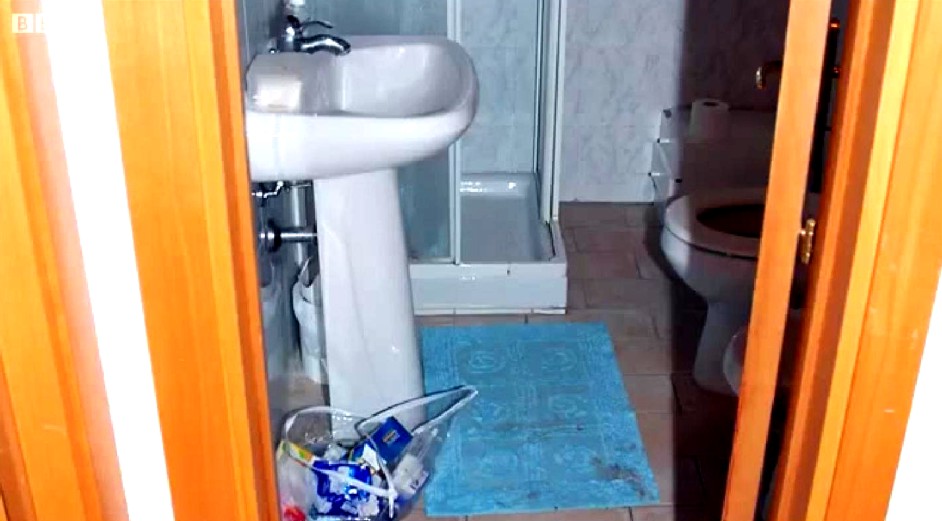
[Please click on each image for a larger and more high-resolution version]
The sheer depth and width of the hard evidence
The defenses really don’t want you to know this: in both width and depth, the full panoply of the evidence against Knox and Sollecito is absolutely overwhelming.
As we remarked in our post below there are far more and far stronger evidence points than UK and US courts normally require for conviction. But only the trial panel of judges observed anything like their full array.
The 2010 Massei Trial Report (which the Nencini Appeal court validated this past January) is a SUMMARY of what was presented to the judges in the courtroom. Those presentations in court were in turn something of a SUMMARY of the hard evidence buried in all the evidence files and the minds of witnesses.
Italian media SUMMARISED for Italians what was to be seen in the courtroom and to be read in the Massei Report. They were barely able to do even summaries for the 1/4 of all the trial hearings that were not open to the media or the public.
UK and US media for the most part didn’t even bother to provide comprehensive summaries (the very fine on-the-spot reportings of Andrea Vogt, Barbie Nadeau and Ann Wise were the main exceptions).
So in effect people in the UK and US attempting to follow the story didnt for the most part receive even a summary of a summary of a summary!
Not one US or UK newspaper or TV network translated the Micheli Report, or the vital Massei Report, or the Supreme Court appeal, or the Supreme Court outcome - only the (mostly professional) translators on PMF dot Org did all that translation.
This post is another example of how far down - beyond even Massei - it’s possible to drill into the evidence, and see it still hold up.
Some past posts on TJMK drilled down to similar depths, on the knives, on the DNA, on the mixed-blood traces, on the phone-events, on the motives and psychologies, and so on. All that evidence too all held up.
Visual analysis of the bathroom-mat footprint
This post mainly consists of high-resolution pictures and measurements. Presented like this, the pictures and measurements largely speak for themselves, and show the real strength of the bathroom-mat footprint evidence.
You will see that as SomeAlibi previously concluded using other methods, this footprint was quite undeniably Sollecito’s. It bears no similarity at all to Rudy Guede’s.
Please click on all images for larger versions in scalable PDF format
1 . [Below] the bathmat and the print, with measurement reference
2 . The bathmat print and the surrounding area
3 . The bathmat print (photo from Polizia Scientifica).
4 . The bathmat print, with vertical and horizontal sizes, from Rinaldi’s report
5. The bathmat print, photo with enhanced contrast.
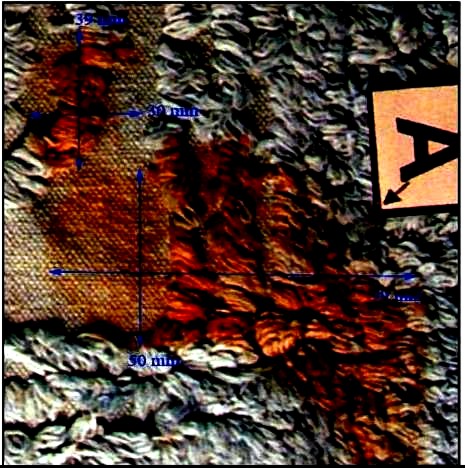
The photo above was modified by highly enhancing contrast.
6 . Enhanced contrast helps to spot some features
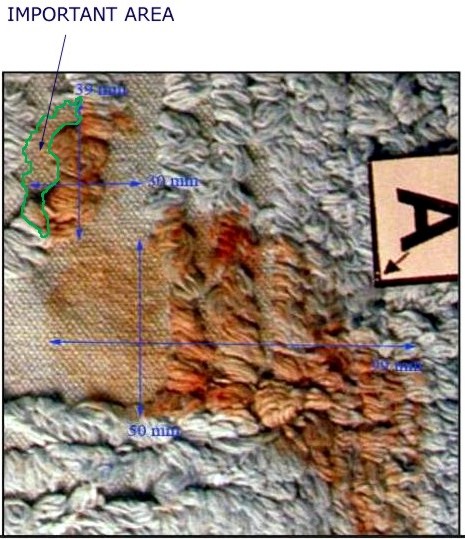
Contrast may help to highlight especially some parts of the print outline.
For example the area on the left labeled as “important area” in the picture (which was “forgotten” in the notorious photo elaborations disseminated by the ‘Friends of Amanda’ group), shows the actual left outline of the “˜big toe’ of the bathmat print.
The toe includes the area indicated in this picture (here the picture is shown again in its original colours).
7. The bathmat, with enhanced contrast
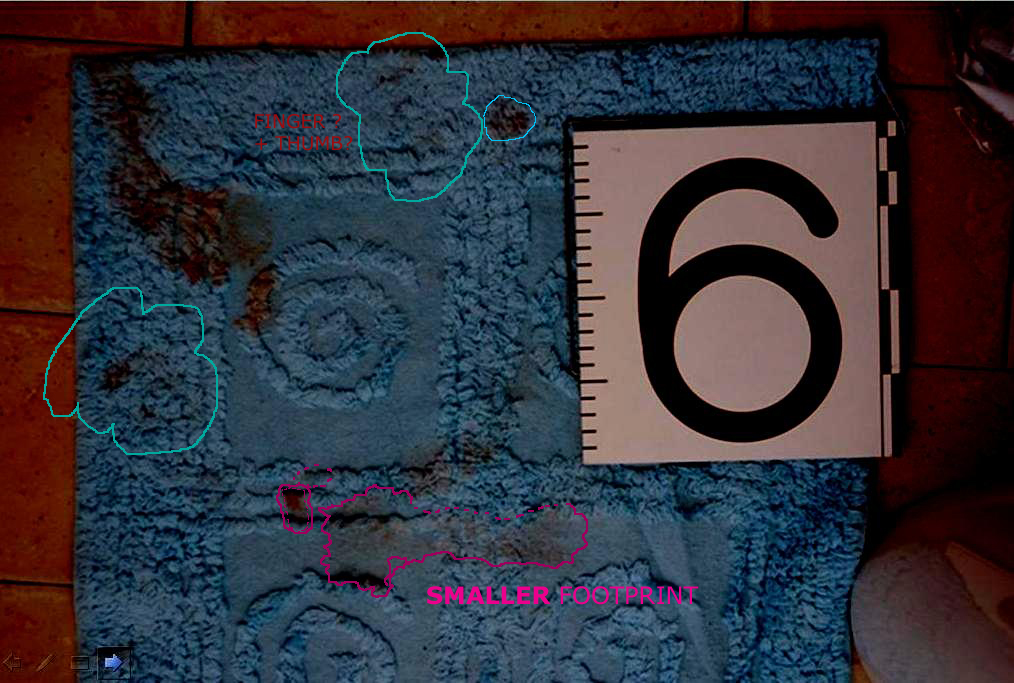
The contrasted image is showing the presence of other stains
There are other stains on the carpet (about another 10, factually situated in one half of the mat area), and also there shows a second diluted footprint (apparently from a foot of smaller size).
8. The selection of a set of red colour shades, outlined by an automatic outline generator
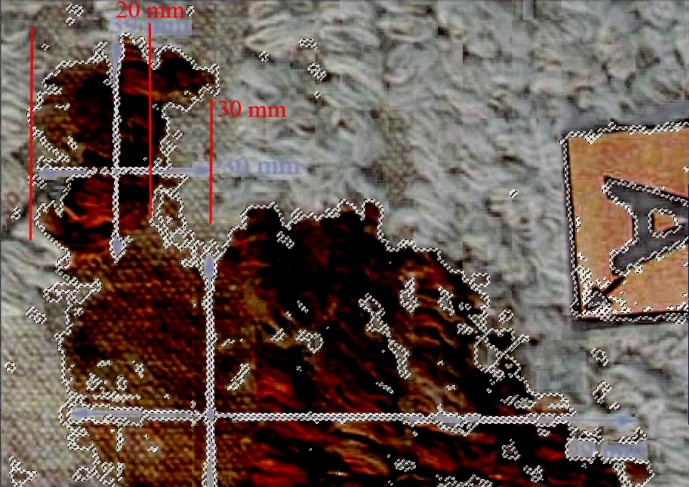
Shows the shape and the possible “˜outline’ of the stain
Reference measurements indicate the width of the “˜big toe’ in millimetres.
9 . A hand drawing of the outline (detail).
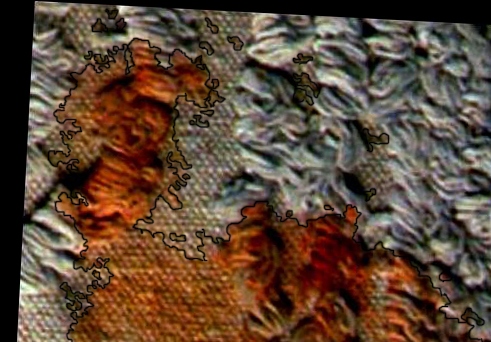
The photography above was modified
The modifications are: +28% contrast, -8% luminosity, + 20% colour saturation, from the original.
An outline has been drawn manually on the photoshop image, trying to be as faithful as possible to the actual stain.
You can notice that, apart from some minor “˜disputable’ very faint areas (such as the area between the toe and the metatarsus) there are only minimal differences between an automatically generated outline and a manually drawn one.
The shapes of the “˜big toe’ are extremely similar in both contours (images 8 and 9), in fact all meaningful features are basically identical.
We consider this manually drawn outline as good for comparison.
10 . The complete hand-drawn outline
11 . Minor detail: small dots separated from the main stain
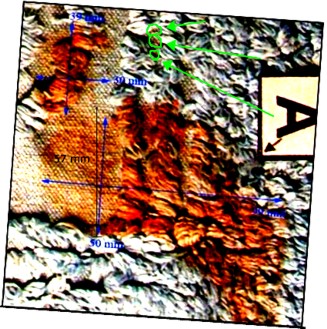
Observe the small red ‘dots’ in the picture above
Although we can’t draw any conclusion about their possible significance, we note the existence of these very small “˜spots’ of a faint red colour shade, separated from the big stain.
They are detected by the computer generated outline above, and that we also see as distinguishable with the naked eye thus we considered them in drawing manually the outline.
We don’t draw any conclusion about them; but because of their sensitive position (they may suggest a “˜small toe’ mark) we take note of them.
The green arrows in the picture point out their position (green circles).
12 . An image in electronically modified colours
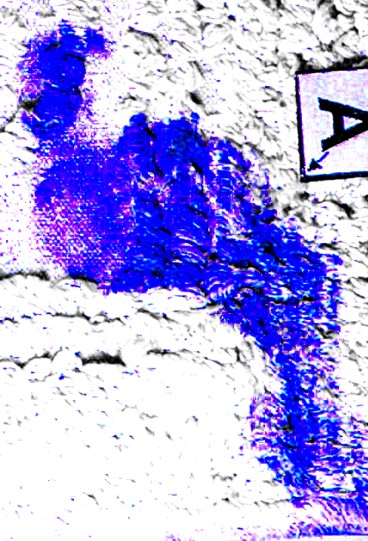
Distribution and intensity of the colouration
As a part of the preliminary study of the stain, we also produced this image above where the computer assigned an artificial colour to an array of shades of ‘red’, thus allowing to further isolate the stain from the background for further assessments about its shape.
This picture shows the distribution and intensity of the colouration. (note: the existence of some above mentioned tiny marks is recorded by this technique too)
13 . The bathmat has a spiral-shaped relief decoration
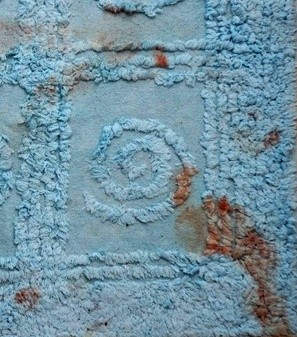
The footprint’s toe obviously balancing on top of the relief decoration.
We think the outline of the “˜toe’ mark of the bloody footprint is affected by the shape of the decoration, in particular the missing part of the toe on the right side, which is remarkably coincident with the margin of the decoration.
So that on that side there is a striking correspondence between the outline of the “˜negative area’ ““ the fabric surface around the spiral, which is lower ““ and the big toe’s outline
This indicates that the outline of that mark on that side was affected by the decoration margin, thus the print there has a “˜missing part’. So the “˜crooked’ bloody area in fact follows the margin of a larger toe.
Because of such coincidence, we can logically assume that the actual shape of the big toe mark appears to be part of a big toe, with larger surface which left its print only partly because part of its surface did not have contact with the fabric, in correspondence of the “˜negative area’.
14. The “negative area”
15. Mat decoration in relief and the toe mark
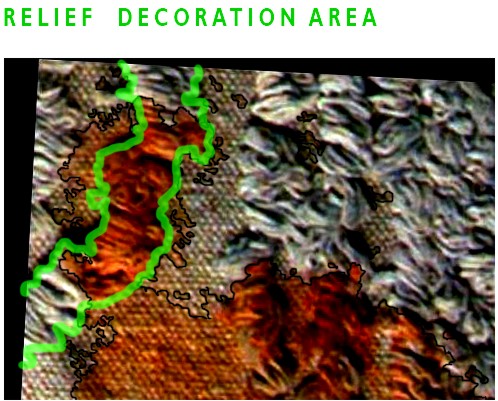
Observe above one single, unitary stain
The remarkable coincidence between the outlines of the decoration in relief and of the toe mark is shown in the picture above.
The rough contour of the print obtained through a smooth curve highlights the shape of the big toe.
Part of the relief decoration outline coincides with the toe mark outline, which shows, highlights and explains how all parts of the red toe mark, that you can see left of the relief decoration, they all belong to one single, unitary stain.
Thus we can deduce that the “missing” area on the right of the toe is determined by the decoration, and coincides with the negative area.
16. Picture (by Kermit) showing a rough shape of the stain
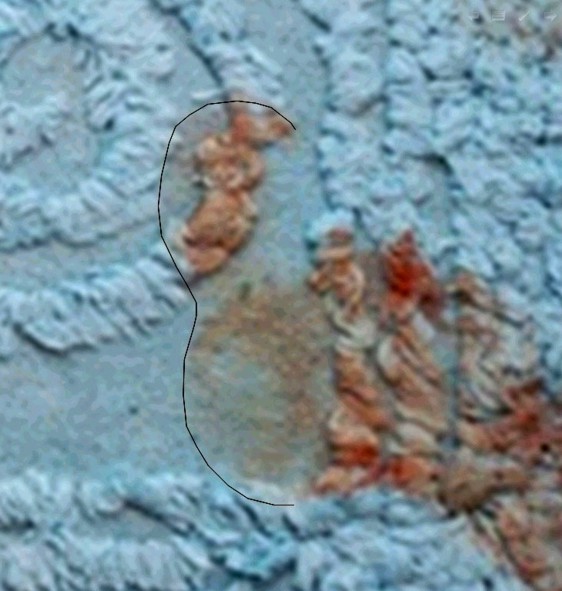
Observe shape, curvature and size
This drawing by Kermit above highlights the rough shape, curvature of left margin and overall size of the big toe.
17. Rudy Guede’s sample print
A copy of this picture together with one of Sollecito’s print at the same scale will be used for comparisons.
18 . Raffaele Sollecito’s sample print
A copy of this picture together with one of Guede’s print at the same scale will be used for comparisons.
19. Part of Rudy Guede’s sample print with Rinaldi’s reference measurements
20. Part of Sollecito’s sample print, with Rinaldi’s reference measurements:
21. Bringing all photographs down to the same scale
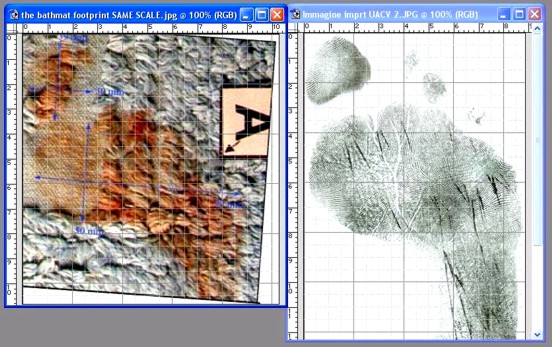
An accurate exercise of scaling was done
This was based on Rinaldi’s referenced pictures. Each one of the Rinaldi’s sample pictures has multiple measurements on several points of reference which allow a high precision determination of their scale and sizes, and thus comparison at the same scale.
In order to further increase scaling precision, the scale was calculated previously and separately for each comparative measurement in the three photos; this was done multiple times for each measurement and the average was picked in order to reduce error as for statistical measurement method.
The resulting final error in the scale is extremely small, far below a threshold of significance that could affect comparison (which was set arbitrarily at 1%, but it’s probably significantly higher, while the actual error is much lower).
In other words, the scale error that may affect your screen pictures will be definitely smaller than any possible perceivable (either significant or tolerated) difference that would be noticed or that may affect the attribution of the stain, when this is compared to the sample.
22. The hand drawn outline is shown again here
23 . The outline (matched scale) overlapped on Sollecito’s sample footprint
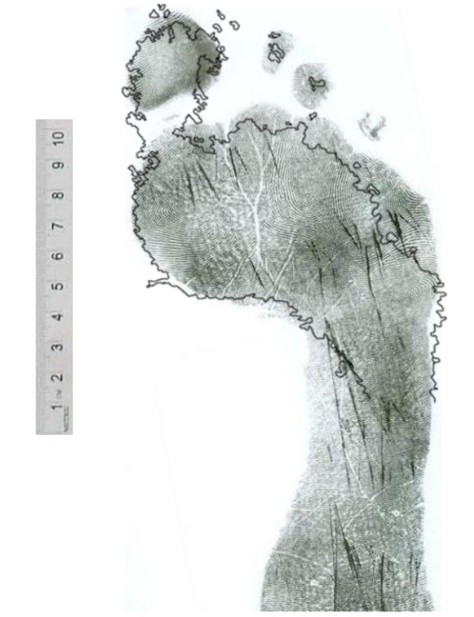
The array of compatibilities with Sollecito
The bathmat stain does not seem to have major incompatibilities with Sollecito’s print; it shows rather an array of compatibilities that can be perceived visually.
One interesting feature is the shape, size and position of a ‘big toe’, that appears as a remarkable coincidence; the toe also has a kind of cleft (see 28 below) on the curvature of its left margin. Another outstanding coincidence is the curvature of the plantar arch on the left.
24 . The same outline overlapped on Guede’s footprint
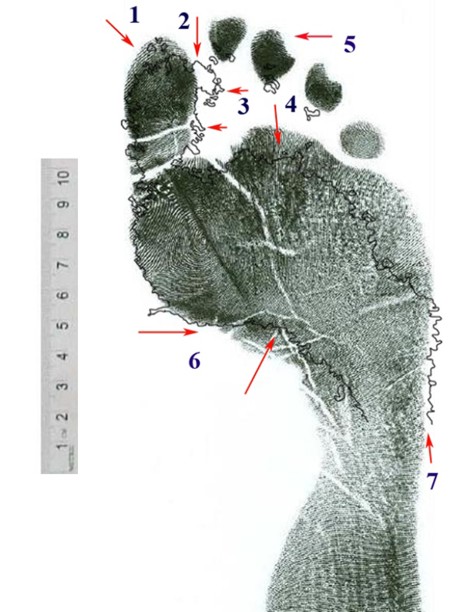
Compare with Guede’s - matched scale.
If you look at the overlapping of the stain outline (see pic 22.) with the sample of Guede’s print (see pics 17. 19.), you may notice 7 major differences, showing a failure of compatibility. Those differences are indicated by numbers (1-7) in the picture .
Each one indicates an area of major difference between the outline of the bathmat stain and the outline of Guede’s sample print. Those measurement differences are remarkably larger than those that can be detected on the overlapping with Sollecito’s sample print.
On the other hand, the compatibility between Sollecito’s print and some very peculiar aspects of the bathmat print (such as a 30mm wide and short toe) were absolutely remarkable.
The differences between the bathmat stain and Guede’s print are :
1) Toe mark of stain is significantly SHORTER than the big toe in Guede’s sample print (a difference of about 7 millimetres). Some people may want to attempt an objection, by suggesting that such a difference may be just a consequence of the position chosen for the overlapping, that maybe the bathmat print was just positioned too low in the picture, the problem may be solved by shifting it up about 7 millimeters so as to make the tip of the bathmat toe ‘coincide’ with the tip of Guede’s print toe.
However, such objection wouldn’t work; it’s a wrong argument. In fact the only possibly correct position for overlapping the bathmat stain outline is determined by the left curvature of the ball of feet and plantar arch (the area of the picture near number 6), which is by the way the most clearly outlined part of the bathmat stain. If you shift the bathmat stain upwards, the outline will miss the match with the curvature of the left margin of the ball of the feet. You will notice that the plantar arch in this area is already very incompatible with Guede’s plantar arch. It tends to become even more incompatible the more you shift the bathmat stain outline towards the toe.
The problem has no solution, since the more you shift the stain outline upwards (in the direction of the toe) in an attempt to make it look more ‘compatible’ with the length of Guede’s toe (or with an upper margin) the more it will become incompatible with the plantar arch. In order to limit the incompatibility of the plantar arch, and in order to keep an overlapping of at least the left margin of the ball of the feet, you need to place it as shown in the picture, this is the position of ‘maximum’ compatibility between the bathmat stain and Guede’s print. Conclusion: the bathmat toe is too short.
2) Toe mark of stain is TOO WIDE (30 mm). It is much wider (30 mm) than Guede’s toe. The number 2. indicates the protruding mark at the upper right, the mark which Giulia Bongiorno desperately insisted on calling a “second toe” mark. In fact, not only would the mark miss completely any hypothetical Guede’s ‘second toe’ in any possible position of the print; also you may notice (highlighted by pics 8. and 9.) how it is not a “mark” itself, but actually it just part of the same area which is entirely continuous in shape and coloration with the rest of the toe mark, and - the most remarkable feature - its right outline is coincident with the outline of the spiral-shaped relief decoration, so that you can reasonably conclude that it is determined by that (the missing area at the lower right of the ‘big toe’ is determined by the existence of the “negative area” of the bathmat decoration).
Conclusion: the bathmat stain has a wider toe mark, however one likes to call it (“big toe”, or “big toe + second toe”) that fails to match any possible part of Guede’s print. The bathmat print is clearly different and incompatible with Guede’s print. It simply cannot be overlapped to any part of Guede’s sample print. Such area is a very significant difference that points outright to incompatibility between the stain and Guede’s print.
3) The toe mark is larger also in the area located at the lower portion of the toe. The toe of the bathmat print in fact has a ‘right margin’ which actually has some additional small marks, small drops protruding towards the right, like droplets maybe produced by the wet cotton fibres of the part in relief which protrude towards the right. This tends to suggest the toe area of the stain may in fact be considered wider: the object that produced it was definitely wider than 22mm, in this area of the toe as well. So also a look at this area confirms that the bathmat stain is wider than 22-23 mm (more towards 30 mm) not just when measured at the upper corner (number 2.) but also at its “lower” parts; here, the small marks caused by the liquid suggest that a larger surface has squeezed liquid from some fabric threads leaving some trace also on the lower area.
4) Bigger incompatibility of Guede on the metatarsus front outline. This area is the front outline of metatarsus: the stain is almost 1cm shorter than Guede’s metatarsus. This happens when you chose the overlapping so as to make the left outline and plantar arch (6.) of metatarsus coincide, as in the picture. Sollecito’s sample print also shows some difference from the stain in this area (pic. 23.) but the difference between the stain and Sollecito’s print is significantly smaller than what you can see in Guede’s print.
5) There are NO SMALL TOES in the bathmat stain. Small toes are completely absent from the bathmat stain (while the tiny blood marks around the stain don’t coincide with their expected position if it was Guede’s print). Such lack of small toes is a peculiarity of the bathmat print. This is a remarkable difference from Guede’s print, and at the same time, a considerable analogy with Sollecito’s print. In fact one outstanding feature of Guede’s print is the evidence that Guede places a big load of weight on his small toes while instead Sollecito has a posture with a weight distribution with the contrary tendency, and obviously he almost does not touch the ground with his small toes.
Thus, Guede’s small toes are all very well pressed on the ground and thus, we can reasonably infer they are somehow naturally likely to get wet if he steps on any wet surface, and anyway they should get wet for sure if the foot is immersed in water or washed (the foot that left the bathmat print must have been immersed in bloody water). The murderer supposedly washed his foot then stepped on the bathmat. In order to attribute the print to Guede we should assume that Guede “forgot” to touch the carpet with his small toes (while instead he puts a lot of weight on them) or that he managed to not rinse them.
6) The outline of the stain has a PLANTAR ARCH that COINCIDES, by curvature and angle, with the plantar arch in Sollecito’s print, while instead it is very different from the plantar arch of Guede’s print.
7) The stain is larger than Guede’s print metatarsus as visible in the right area of the stain. The difference is rather significant, almost half a centimetre, that is bigger than the difference with Sollecito’s print which instead coincides for a trait. This difference cannot be “solved” in any way since, even if one wanted to claim that the scale is wrong and that the stain should be sized down, this would make the toe, already too short (as in 1.) become even shorter.
If instead the toe length is adjusted the metatarsus becomes even less compatible with Guede. We recall that Massei found that Guede’s feet had a print overall more slender than Sollecito’s.
25 . Other features:
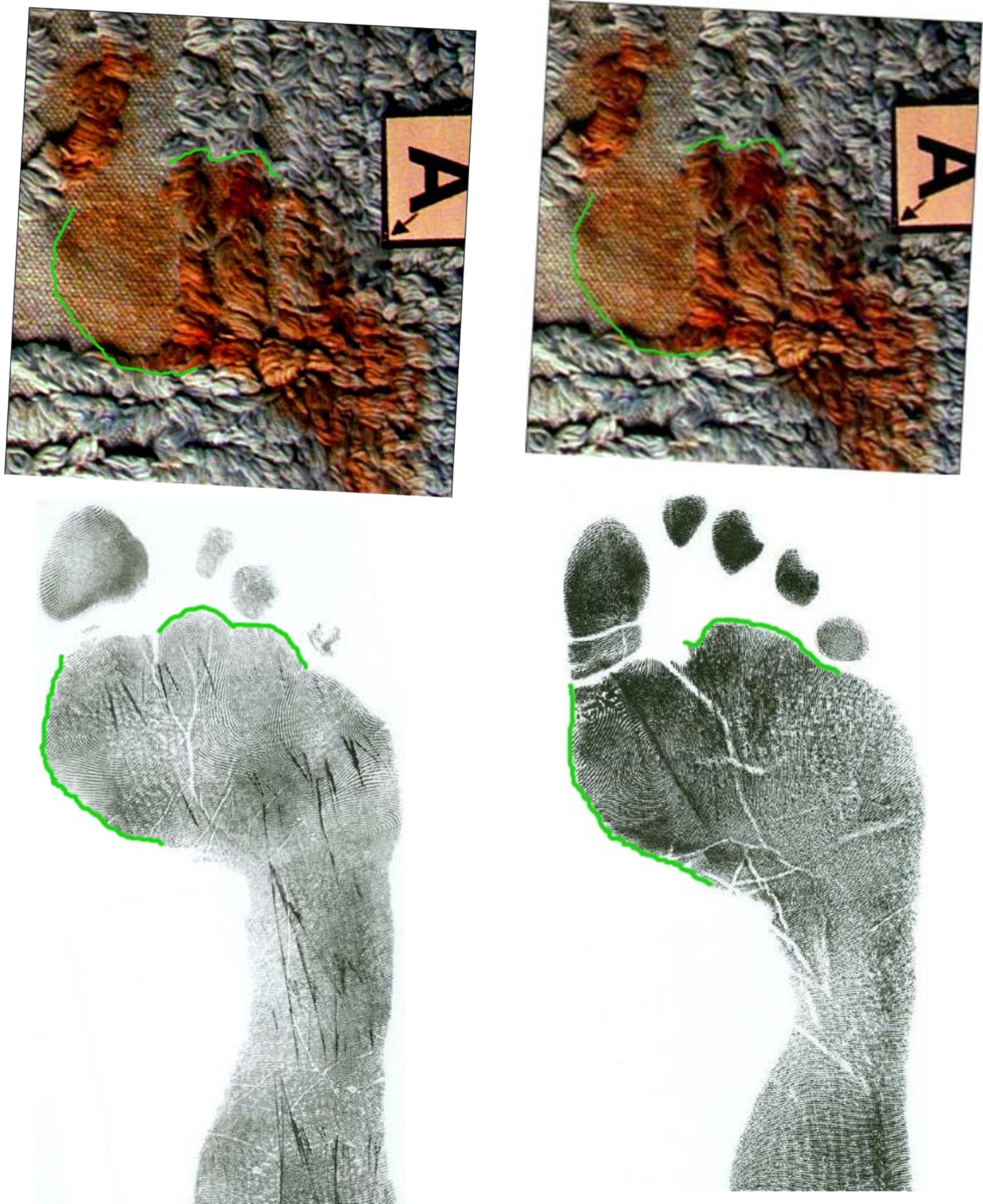
Curvatures of plantar arch are very different
The plantar arch curvature, highlighted in two different drawings (the second highlights also the upper outline “hunches”); the plantar arches in the two sample prints of Sollecito and Guede are shown below. The curvatures of plantar arch are very different.
26. The outline curvature generates different angles
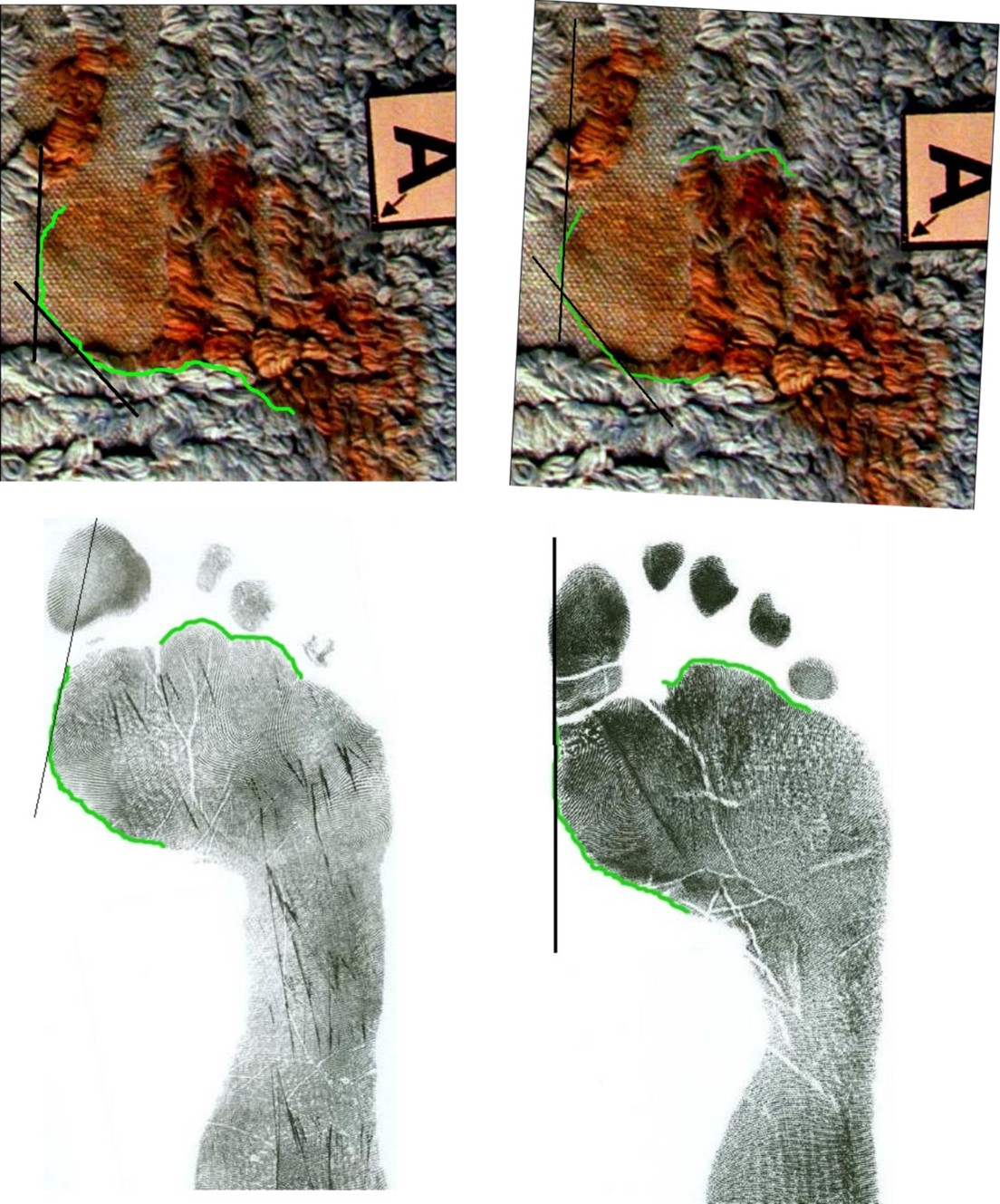
Sollecito’s and Guede’s plantar arch curvatures have very different angles. Also the left outline of metatarsus maintains a different curvature. Sollecito’s outline has an angle (see outline tangent) intersecting the toe (the metatarsus has a “bunion”); in Guede’s print there is basically no intersection, the outline and the toe form almost a straight line.
27 . Plantar arch curvature angle differs between Sollecito and Guede
If you consider the vertical axis of the sample footprint, and its orthogonal line, you may notice how the plantar arch curvatures of the two prints accomplish different angles: the two angles are VERY different, not just three or four degrees.
The (too) narrow angle of Sollecito’s plantar arch probably has a relation with the protruding outline and angle seen in pic 26., and seems related to a hallux valgus (which Guede does not have).
28 . The “cleft” on the left side of the stain
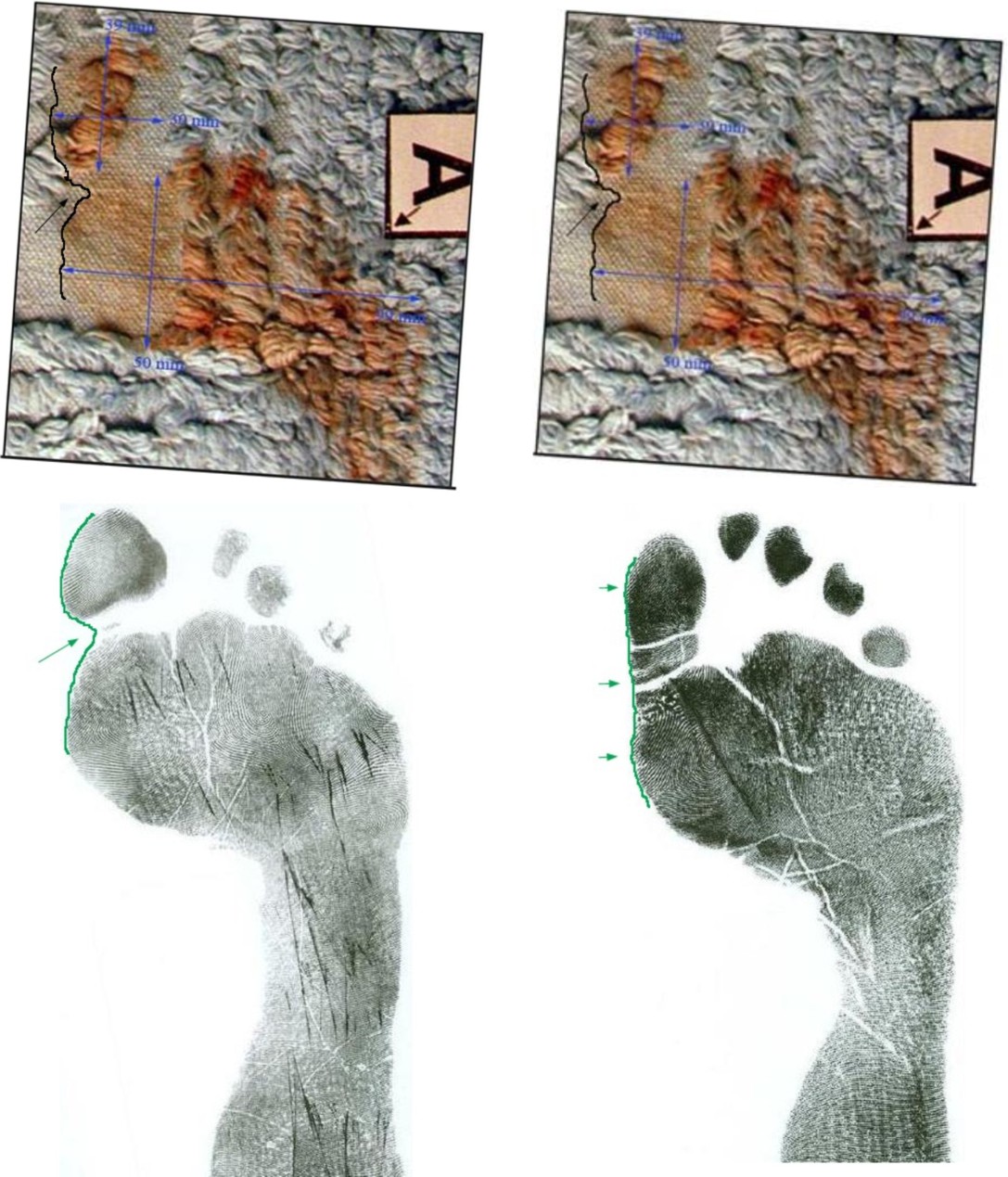
The “cleft” on the left side
This has a correspondence with one sample print, not so with the other.
29 . Table of metric comparison (by SomeAlibi)
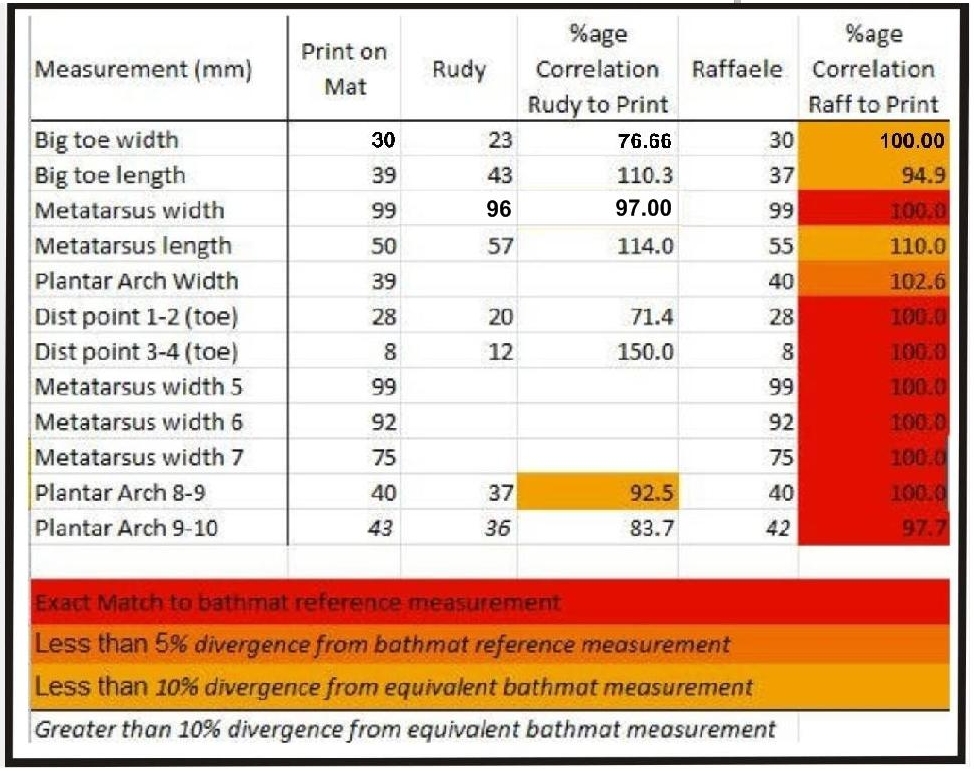
SomeAlibi’s post of a year ago
Comparison of measurements and analysis of correspondence degree of bathmat print, with both Guede’s and Sollecito’s sample prints.
Wednesday, February 19, 2014
Our Reviews Of The Painstaking BBC-3 Report First Aired In The UK On 17 February 2014
Posted by Our Main Posters
Review by SomeAlibi
Watching “Is Amanda Knox Guilty” was a funny thing. I suspect for people following the case closely, on either side, it was a sobering experience. Not because it changed perspectives, but simply to see how quickly one hour passed and the necessary trade offs that had to be made to fit within that schedule. The opportunity cost was a level of detail to which in-depth followers have become accustomed.
Just one example: Sollecito and Knox’s partial alibi that they were checking their emails on the night of November 1st was explained as being challenged by two broken computers. Perhaps, (although unlikely to be the material issue) but where was the much more salient fact that their ISP records showed that was conclusively untrue? Where was the challenge: if you say you’re checking emails to establish part of your alibi against a murder and it is shown to be absolutely untrue, what does that suggest…?
There were many other “clinchers” that had to be let go in the name of brevity. But it wasn’t that sort of documentary - it was neither a case for the prosecution or a case for the defence: it put the main suggestions at the level of detail that was possible and it allowed both sides to speak to the points at that level of detail.
I find it interesting that there has been such a howl of bias from those supporting Knox and Sollecito. Objectively there’s no good ground for it: the documentary allowed both sides forward in equal measure and no pro-justice watcher would celebrate it as a pro-conviction piece.
The arguments were balanced, the video, audio and picture quality eye-opening. For those on the other side, their markedly different reaction appears to be that the documentary has broken the taboo that The Evidence Shall Not be Told. The idea that there is an easy-to-consume piece that puts forth the case and defence equally is seen as a disaster.
The campaign for Knox continues to be obsessed, beyond all things, with trying but now failing to make sure the public doesn’t know the basis of the case. For a long time they hoped to drown out the multitude of terribly inconvenient truths within it by screaming “no evidence”. ‘Is Amanda Knox Guilty’ put the lie to that conclusively, but fairly, and now many hundreds of thousands, perhaps soon to be millions will ask themselves why those supporting Knox and Sollecito have had to adopt this tactic at all.
If they really are innocent, why has the case against them been so comprehensively white-washed in the US?
The conclusion, is rather simple and I saw it encapsulated on a large television screen last night with the repeated clips of Amanda Knox and Raffaele Sollecito outside the cottage kissing and “comforting” each other: there for a fraction of a second, shown several times, is Amanda Knox, unable to stop herself glancing at the camera filming her and stealing her gaze away again very quickly pretending she hasn’t.
It’s a look that says everything: furtive, pretending it didn’t happen, immediately covering up in a way that poses a stark proposition: why on earth would you do that if you had nothing to hide? And like so much of the multiple collapsing alibis and non-working answers and the desperately dishonest fingers-in-the-ear “no-evidence” pretence of those supporting her, is a proposition that can withstand no scrutiny.
Review by SeekingUnderstanding
What a relief to watch a very clear and unbiased narrative. The quality of the visual information was top rate - seeing so much original footage, and presented as it was in a logical time sequence.
Even though I was already familiar with the evidence, including the photographic material, I found it very helpful to see it all presented in this way. I appreciated, too, hearing and seeing the excerpts in original Italian (along with English translations). It added even more authenticity.
I hope that, at long last, this will have helped some - or hopefully many- people to see that the two ‘camps’ in this case do not divide into AK supporters and AK ‘haters’. There are the FoA and their followers ...and there are the others who seek the objective truth and justice.
If hate has been generated in some quarters, then the Knox (and Sollecito) camps need to look to themselves and their own behaviour. This programme was important in the tone it set.
I actually found it to be quite lenient towards the defence on a number of counts.
There were several instances where the defence point of view could have been strongly countered by known and established facts, but, bending over in fairness, these were left unanswered.
Here are just four instances :
1) In the discussion around the blood and DNA left in the bathroom - Dr. Gino’s assertion that ‘the blood/DNA ‘could have come from anywhere’ might have been countered with AK’s own declaration that the bathroom was previously clean. Dr. Gino also suggested a very improbable scenario of ‘it could be saliva’ (on the bidet?). Cassation emphatically said that it must be shown HOW any suggested contamination could have occurred.
2) There was a missed opportunity in discussing the knife presumed to be the murder weapon to mention Sollecito’s lame, unreal excuse of ‘Meredith pricked her hand’ etc.
3) Anne Bremner stated ‘Amanda could not have turned overnight…into a murderer’. Attention could have been drawn to many things, both physical events (her predilection for cruel pranks, including a staged burglary in the US, and wild parties, etc), and also many psychological indicators that would have clearly shown how her behaviour has, in fact, demonstrated consistency.
4) In the discussion re the bra clasp, the delay partially being caused by the defence themselves was not mentioned. Also, detailed discussion re the one bare footprint on the bathmat was omitted.
Since there is, in fact, so much evidence, it must have been difficult to chose and balance what did go into the hour long programme. All in all, I feel Andrea Vogt and her team worked hard, and did very well to let the facts speak for themselves.
I hope it will lay a few fictions and myths to rest.
Review by Earthling
What is the “Amanda Knox trial” (really the Meredith Kercher murder trial) really about? Is it about an innocent 20-year-old pretty white girl being railroaded by the medieval Italian justice system?
Or is this actually a murder trial, about the fact that a beautiful, intelligent, ambitious young woman, innocently trying to improve her life by study abroad, was brutally murdered?
I believe it’s the latter, and the BBC3 production gives us one of the first truly balanced reports on this trial.
The filmmaker starts from the beginning, and takes us through the murder, investigation, and various trials and appeals up to the present day. Instead of the breathless “Perils of Penelope” tone (toward Amanda Knox) that most such previous “documentaries” have taken, this one takes a sober look at the actual evidence.
Did you realize that there are luminol-revealed bare footprints in Knox’s size in the apartment? Luminol reveals blood and a few other substances; but those substances can be ruled out because the test was done six weeks after the murder, by which time those substances would have dissipated.
Blood doesn’t dissipate. This documentary shows you those bloody footprints in all their creepy glory, something never shown on American TV before.
“Is Amanda Knox Guilty” also speaks of the actual DNA evidence in the cottage linking Knox to the murder, including five mixed-DNA spots (Knox and Kercher) that tested positive for blood. Both prosecution- and defense-oriented experts are allowed to comment on this evidence, and the viewer is allowed to make up his or her own mind.
My one criticism is that a lot of the evidence against Knox (witness statements, cell phone data, fake break-in) is skimmed over or not even mentioned. Also, because the documentary quotes Rudy Guede’s position at length without any contradictory narrative, it is confusing as to whether the filmmaker might have believed him.
In the end, the filmmaker says, he was convicted of participating in the group murder. However, a stronger statement against his “I’m entirely innocent” defense would have been good.
Other than these quibbles, this is the best documentary on the Meredith Kercher murder case that I have ever seen.
Review by ZiaK
I watched the BBC programme on the Meredith Kercher case hoping for a more balanced view of the case than has been presented in the English-speaking media to date.
The documentary does present some of the evidence against Knox and Sollecito - including the bloody footprints, the mixed blood/DNA traces in the bathroom and corridor, the bra clasp, the knife DNA evidence, the strange timings of phone calls to police, the unlikelihood of the “break-in” being anything other than staged - but omits to point out that none of the other flatmates’ DNA was found in the blood traces, so saying that “it’s because Meredith and Amanda shared a flat” is misleading.
Nor does it point out that, although the murder knife was found in Sollecito’s flat, none of HIS DNA was found on it: it had only Amanda’s and Meredith’s DNA.
The programme didn’t cover the cell-phone evidence, showing that neither Knox nor Sollecito were where they said they were, at the times that they claimed. The programme also repeated the “Friends of Amanda” PR soundbites, such as “there was no evidence of Amanda in the murder room” - whereas the fact that her footsteps tracked blood OUT of the room are actually evidence of her having been present IN the room before it was locked (i.e. at the time of the murder).
Furthermore, in my opinion, the narrator’s voice seemed to evince sympathy towards Amanda, rather than describing events with a passive or objective tone of voice.
As one of the translators who has participated in translating case documents (such as the judges’ reports describing why they came to their decisions), I am only too aware of the extent of evidence against Knox and Sollecito, and I would like to see knowledge of this evidence become more widespread throughout the English-speaking world.
The BBC programme is a step towards this, but in my mind, only a very small step. I hope the pace will pick up soon, and more objective and extensive knowledge of the true facts of this case will be made available to everyone so they can form a rational opinion of the case based on true understanding.
Review by Cynthia
I’ve just watched this, and it’s very good - with a huge amount of footage hitherto unseen (directed by Andrea Vogt).
For what it’s worth, I note the following points:
1) There’s no mention of Meredith’s friends who heard Amanda say ‘she fucking bled to death’ before the fact was known to anyone else. Perhaps they didn’t testify, being too distressed? If so, it’s a great pity, because it seems a veritable clincher that hasn’t been used at all.
2) The bra DNA arguments are quite extraordinary. If we can determine that we all have Neanderthal DNA (tho’ I know a lot of American fundamentalists don’t believe that mankind goes back more than 6,000 years!) I can’t for the life of me see why DNA would be unusable after a poxy delay of 12 days ...
3) The argument that the Luminol traces may indicate not barefoot treading in blood but in bleach seems absolutely unbelievable to anyone who does housework (like me!) Bleach is horrible stuff, and you really, really don’t want to be getting it on your bare skin. Even Amanda, with her vestigial domestic skills, would have noticed if she’d trodden in it.
4) Bremner says Amanda was an honor student. She wasn’t; she had funded herself (not that that’s discreditable). (Also, are honor students unable to write cursive script? The shots of her handwriting show that she can’t do joined-up writing. [Or thinking.] I don’t know whether the phrase exists in American English, but not doing joined-up writing is a term of great intellectual contempt in English.)
5) We saw Amanda’s ‘mask’ speech. This is really interesting - who would even think that masks were being put on them if they weren’t using them themselves?
6) The programme mentions the little-reported fact that another, smaller knife found at Sollecito’s also had Meredith’s DNA on it.
7) The film omits to mention Hellman’s lack of any experience in criminal trials.
8) Every shot of Amanda in the film has her talking about ‘me’ and ‘I’. She never, ever mentions Meredith - it’s all about HER suffering. She never even says ‘the murderer is out there - I wish you’d stop persecuting me and get them’.
Presumably this is because Guede is supposed to be the sole murderer - and nobody seems in the slightest bit worried that there’s no murder weapon with HIS DNA on it! (Yes, there are his turds - but that wasn’t what killed Meredith.)
9) FOA has used the fact that the recent jury took 12 hours to deliberate over the verdict as an indication that they couldn’t agree. But why not just that they were being extremely careful and re-examining everything?
10) Finally, just an observation: Maresca speaks the most beautiful Italian - you can hear every word calmly flowing past.
Review by Miriam
Much appreciated. Outside of the Porta a Porta transmissions on the case, the best I’ve seen.
I understand they had to give both sides, but I felt that the defense came out on the losing side. I thought it funny that it was implied that since they only tested for blood it could of been saliva.
I don’t believe even her supporters would argue that Knox was so quirky as to brush her teeth in the bidet! Or maybe she spit in the bidet, in which case Meredith would have had every reason to complain about her bathroom habits!
Now if only this or something like this would air in the U.S.
Review by Sara
This is actually one of the most objective and well-researched reports I have seen on the case and I am very happy that BBC has managed to be so unbiased.
It presents both sides of the story equally well and does an excellent job of countering the extremely silly “no evidence” argument that the FOAkers like to repeat at equal intervals.
Regardless of what one believes, I think the documentary will at least succeed in convincing most people that there is indeed sufficient evidence against the two of them, and Italy’s judicial system is not crazy to convict people without any evidence.
My favourite part was when the defense DNA expert (can’t recall her name) tried to explain away the mixed blood evidence by saying that one of them could have had a nose bleed, and the other could have cut her hand in the same place leading to mixed blood.
Come on already, what are we? Kindergartens making excuses for not handing in homework? What is the possibility that both of them would bleed in exactly the same places not once or twice but multiple times? I think anyone with a bit of sense can see that they are clutching at straws.
However, I was a bit disappointed that few things were missed out. For instance, the fact that Guede’s footprints led straight out of the house, the fact that Amanda’s lamp was found without any obvious reason in Meredith’s room, Amanda’s extremely odd midnight call to her mom that she conveniently “forgot”, her million showers despite her concern towards “water conservation” etc.
Sollecito’s multiple changing stories were not really elaborated upon (the story in which he went to a party, the one in which he checked emails, the one in which he pricked Meredith etc etc).
Also, inconsistencies between their accounts of various events could have been pointed out (Was Filomena’s door open or close? Did AK call Filomena from the cottage or from Sollecito’s house? etc).
Witness accounts were not given any screen space either. I think touching upon these would have made the documentary even more impressive.
That said, I understand that the team has done the best they would within the limited time they had, and everything just cannot be accommodated within one hour.
So, all in all, kudos to the team and BBC for a job well done.
Review by Odysseus
I though it was a very competent overview of the case. After so much pro-defendant spin in the MSM (no doubt engineered by the American defendant’s PR outfit), it was refreshing to have a sane, measured and rational presentation. The victim deserves no less.
Congratulations to BBC3 and to the programme makers. It’s good to know that the BBC of blessed memory hasn’t been entirely dumbed-down nor intimidated by “partial outside interests”, the latter being director Andrea Vogt’s own description of the forces intent on muddying the waters in this case.
Tuesday, February 18, 2014
Congratulations To The BBC For A Report Emphasizing The Sheer Extensiveness Of The Evidence
Posted by Our Main Posters
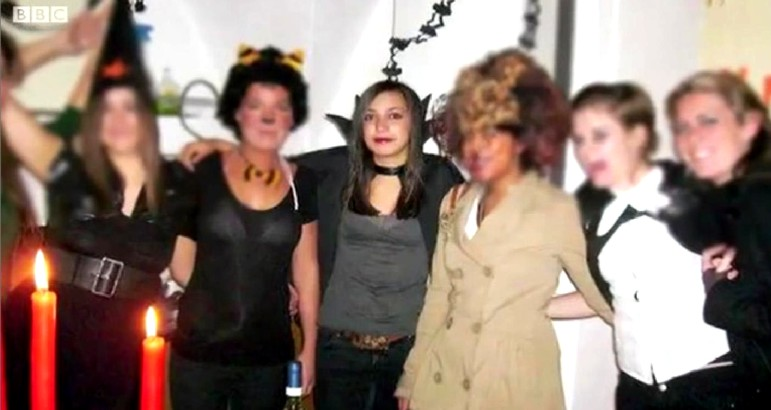
[From the BBC report: Meredith the night before the cruel, deadly attack with her Halloween friends]
This is the painstaking and obviously expensive report by Andrea Vogt and Paul Russell with interviews in London, Seattle and Perugia.
It was aired by the BBC on 17 February. Considerable time is allocated to defense lawyers and experts and the Knox family and Ann Bremner of the FOA taking their best shots at explaining how Knox could maybe have not been involved.
Still, the sheer mass of the evidence remains as the 80,000 pound elephant in the room, lacking any hint of a realistic alternative explanation. Three people committed the horrific attack, including Rudy Guede and two others.
Only Knox and Sollecito remain pointed to by dozens of evidence points as those two others. Not one single evidence point indicates anyone else was involved. The Masssei trial court got it right as the Nencini appeal court just confirmed.
We will enquire if we can embed the hour-long video. But as it may be picked up by US and other foreign media outlets, we will start by simply summarizing it soon. Assessents by those who have already seen it are welcomed.
Saturday, December 14, 2013
Why Is Appeal Prosecutor Crini So Very, Very Interested In The Precise Position Of Filomena’s Door?
Posted by Cardiol MD
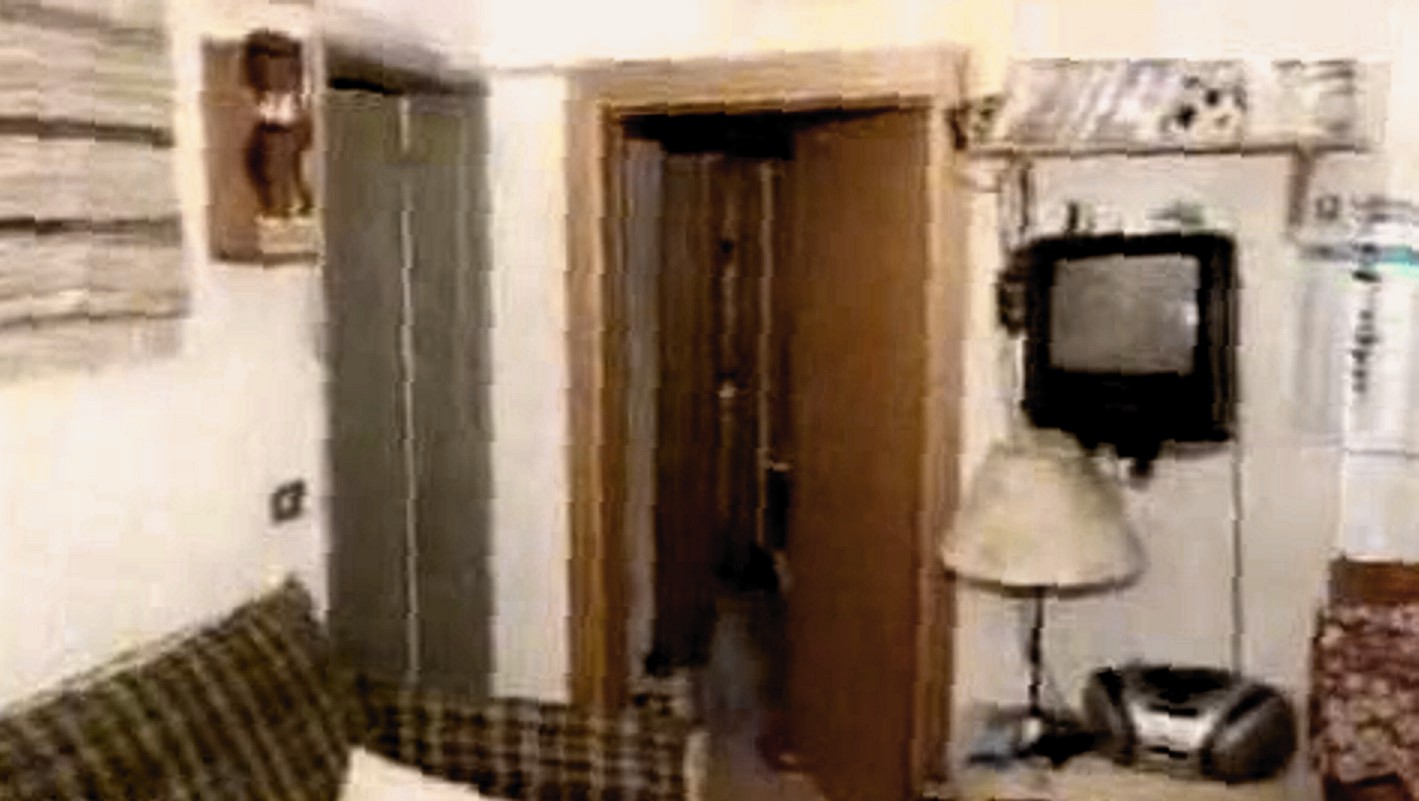
[Above, we can see Filomena’s grey door, at hard left; ahead are Meredith’s & Knox’s bedrooms]
Do please bear in mind that this appeal was initiated by Knox and Sollecito, and the verdict, sentence and sentencing report they dispute is Judge’s Massei’s from the 2009 trial.
The subject of one of Dr Crini’s focuses - whether or not Filomena’s door was open at the various times Knox and Sollecito stated they went to the women’s apartment on the morning-after ““ is a crucial one, relevant to proving Knox’s and Sollecito’s lies and obfuscations.
Wasn’t the staged break-in to Filomena Romanelli’s room glaringly obvious? In the early morning of November 2nd, 2007? In spite of the Knox/Sollecito obfuscations? There is much information in Massei on this question, pointing to many very obvious obfuscations.
Now, for the legal requirements of beyond-reasonable-doubt (BRD) actual, literal quotations are needed. Much relevant information can easily get “˜lost in translation’ not only at the superficial level of paraphrase, as in “They said that”¦..”, but also at the more subtle level of the formats used for quotations.
Some of the Massei Report as translated consists of the actual oral quotations of witness statements, some are quotations of the content of written documents, but some consist only of paraphrases of both oral statements and of written documents.
For some quotations, especially nested-quotations the translation uses various formats, beginning either with a comma or an apostrophe, ending with an apostrophe, and, in my copy, some back-slashes.
This mixture can be confusing to some readers, and Knox and Sollecito are seasoned veterans of exploiting such translational losses. That is a major factor in their continuing obstruction of justice: using chronic obfuscation.
He said, “She yelled, ‘I’m going to kill you.’ “
This quotation-format has been substituted in this post where it seems appropriate. It is hoped that when this format is used only to indicate editorial irony it will be self-evident.
John Follain and Will Savive also make a number of relevant references, and so do some Wiki articles whose authors are too modest to identify themselves though “˜Underhill’ has been mentioned as a co-ordinator.
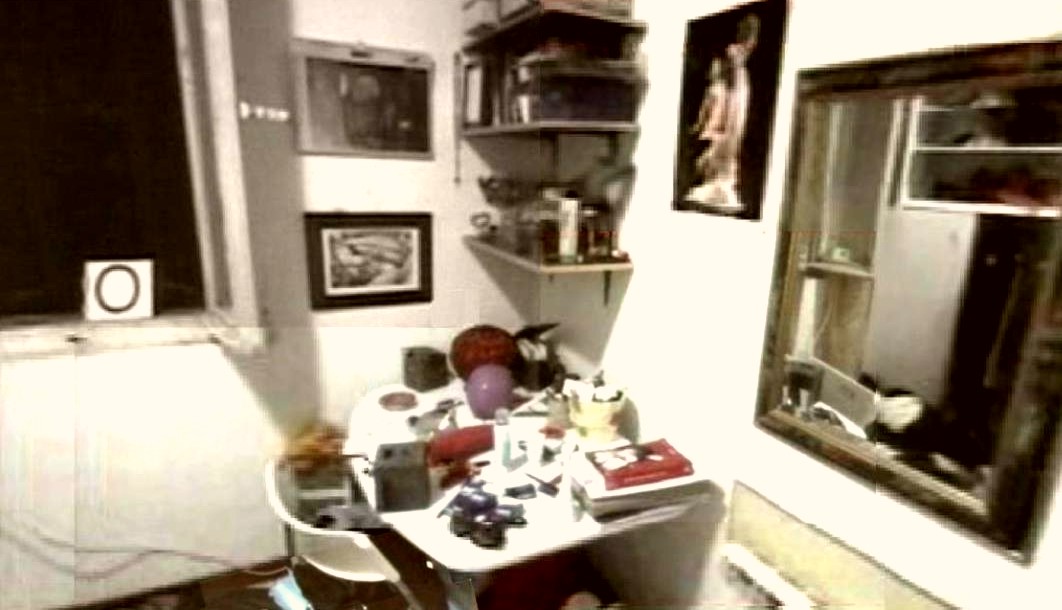
Of course, the members of the Florence Appellate Court have access-to, have probably already read, thousands of pages of evidence, including the actual verbatim witness-transcripts, and that Court will make up its own mind independent of what is written elsewhere.
Here are some of the Massei “˜door’ instances - this is a selection of a relevant 6 out of a grand total of 192 instances:
Massei Page 28: [Amanda Knox and Raffaele Sollecito ““ said that they were waiting for the carabinieri whom they had called since “coming back to the cottage in the morning because they had been away for the night” and finding “the entrance [15] door open and then the window broken” (see declarations by Battistelli, hearing of February 7, 2009, page 64).]
Access to the Court Records would help us better-understand this passage, but Follain (Page 67, Kindle location 939), indicates that Battistelli is actually quoting Sollecito, substituting “˜they’ for “˜we’, so it seems that Sollecito was already obfuscating the facts, encouraging the inference that their shocking observations began only when both he and Knox arrived together and discovered together both the open apartment entrance-door, and from inside Filomena’s room, the broken-window, so we are all being steered away, by Sollecito, from the true answer to our question.
Massei Pages 29-30: [Around midday(Nov, 2nd, 2007), at ten past twelve, when they had not yet arrived at the car park of the Fair, and she(Filomena) was in the car with her friend Paola Grande, she received a phone call: it was Amanda letting her know that there was something strange. She had arrived and had found the door open: she had had a shower and it had seemed to her that there was some blood; moreover she said that she was going [17] to Raffaele’s place (declarations of Romanelli page 31, hearing of February 7, 2009).
To her (Filomena’s) question about where Meredith was, she had answered that she did not know.]
Filomena had apparently not been told by Knox, in this 1st phone-call, about the broken pane, the stone, and the bedroom-disarray, as if Knox was not yet aware of these stunning facts. The obfuscation continues.
Massei Page 30: [Marco Zaroli, who was without a car because Ms. Romanelli had taken it, had called his friend Luca Altieri and they had gone together to the house in Via della Pergola, where they arrived around 1:00 pm, at almost the same time as Filomena Romanelli and Paola Grande. In the house there were the also the two present accused and ““ as we have seen ““ Inspector Battistelli and Assistant Marzi. The presence of the latter two was linked by Ms. Romanelli to what Amanda had told her about the open door, the broken pane, her own room in a mess.]
When Knox first told Ms. Romanelli about her visit, she had omitted reference to Laura’s and Filomena’s doors, whether they were open, whether they were openable, whether Knox opened them, and whether Knox looked inside and saw the broken pane, the stone, and the bedroom-disarray. It is implausible that Knox tried only Meredith’s door and not the others.
It is also implausible that Knox even took a shower at the women’s apartment, colder as it was than Sollecito’s. Amy Frost testified that hours after the body was discovered Amanda Knox told her that she never took the shower, because when she noticed the blood that had stopped her from showering.
The Postal Police commented that Knox also emanated an unpleasant, “˜post-shower’ odour, inconsistent with Amanda having recently had a shower anywhere, implying Knox was lying about taking the shower.
Knox is steering Ms. Romanelli away from these crucial facts which logically demanded that their “˜discoverer’ flee (again), and call the Police. Knox is obfuscating by selective piece-meal feeding-of-the-facts to Filomena.
Massei Page 38: [On the day of November 2, 2007 at police headquarters, Amanda was also there and she said that that night she had been with her boyfriend Raffaele and that the next morning at around 11:00 am she had gone back home to get changed. She had found the entrance door open and this seemed strange to her: she had gone into the house and into her room and she had taken a shower and had seen drops of blood.
She said that after the shower she got dressed and noticed that Meredith’s door was locked. She went into the other bathroom and said that there were faeces in the toilet. Then she went into another room and noticed that the window had been broken and that there was glass inside. She told these things to her and the other girls present. Then she related that she had gone back to Raffaele’s house and had rung Filomena. She remembered that on that occasion at police headquarters Raffaele was very calm, silent.]
When Knox first called Filomena, Knox had omitted any mention of the most significant information - the (staged) break-in, as if she had not ‘noticed’ it.
Now, later, paraphrasing, Massei states: “Then she went into another room and noticed that the window had been broken and that there was glass inside.”
Had Massei not paraphrased, but had written “Then I went into Filomena’s room and ‘noticed’ that her window had been broken and that there was glass inside.”, we could use it as BRD evidence.
The actual, verbatim quote should be among the many thousands of Court Records relied upon by Massei; Nencini’s Court should use such Record in reaching its decision.
Massei Page 65: [Upon returning home, she [Amanda] noticed that the door was wide open. She thought someone had gone to take the trash out or gone to the floor below, closing the door behind them but not locking it. She asked loudly whether anyone was at home, but no one answered. The door to Meredith’s room was closed, and this meant she was sleeping. She undressed in her own room and took a shower in the bathroom, (the one) nearest to (both) her room and to Meredith’s.
When she got out of the shower, she realised that on the little bath mat where she had placed her feet, there was blood and also, there were drops of blood on the sink and the faucet. She left the bathroom and went to get dressed in her own room. Then, she went in the other bathroom to dry her hair, where there was a blow dryer. It was at this time that she noticed feces in the toilet, which surprised her. She then took the mop and returned to Raffaele’s home, locking the door (on the way out.)
She told Raffaele what she had seen and he suggested that she call one of her friends. She then called Filomena Romanelli, who said that she had been out with her boyfriend and that Laura Mezzetti was also away, in Rome with her family. She then realised that the only one to have spent the night in Via della Pergola was Meredith, about whom, however, nothing was known. Filomena seemed worried, so Amanda (Page 66) told her that she would call Meredith, who would then call her back.
She then called the two cellphones that Meredith had, but without getting any response (from her). She then returned home, this time with [55] Raffaele. Upon returning home, she opened the door to Filomena Romanelli’s room and saw that the window was open and completely broken: there was chaos, “šbut her computer was in its place on the desk.”› Convinced that there had been a burglary, she went into the other rooms: Laura’s room was in order, and nothing was missing from her own room.
However, Meredith’s door was closed. She began to knock and to call out, without receiving any answer. She was then seized with panic and went on the balcony to see if she was able to see anything, but she couldn’t see anything. She went down to the apartment below to ask someone, but no one was there. She therefore went back inside and Raffaele said that he wanted to try to break down the door of Meredith’s room, but he wasn’t able to. It was then that they decided to call the police, which is what Raffaele did. She let Filomena know about this, asking her to come home.]
Now, only after returning “home, this time with [55] Raffaele.” does Knox allege that she had then “opened the door to Filomena Romanelli’s room and saw that the window was open and completely broken: there was chaos, “šbut her computer was in its place on the desk.”
Knox continues to obfuscate by selective piece-meal feeding-of-the-facts.
Massei Page 66: [While they were waiting, two police officers arrived (at the scene) and she showed them all that she had seen. Then Filomena arrived with her boyfriend and two other friends, and they broke down the door of Meredith’s room.]
True. There are a number of other Massei references to Filomena’s door and room, but they are basically repetitive of information already in the above references.
This seems to be enough for Nencini’s Court to reach its verdicts re Knox and Sollecito.
[Below: the area from which Knox would have been looking at Filomena’s door]
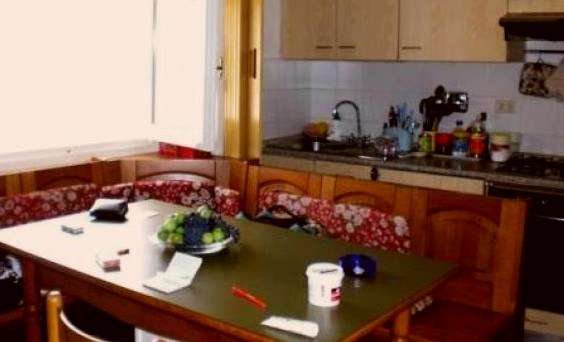
Monday, November 25, 2013
Appeal Session #4: Today Lead Prosecutor Alessandro Crini Summarises The Prosecution’s Case
Posted by Our Main Posters
Overview
This is the report on the first day of Prosecutor Crnini summarizing the entire case.
This was not attempted at such length at the 2011 Hellman appeal and that panel of judges was perhaps not ever fully in the picture. The second day of the presentation is reported on here.
Real-Time Reporting, Bottom-Up
5. Good reporting on the court today
Andrea Vogt has posted an objective report here and Barbie Nadeau an objective report here. We will post excerpts from both and other sources after the appeal session on Tuesday is done.
5. Warning about AP’s Colleen Barry
The Associated Press’s Colleen Barry is once again filing highly biased reports from the court. This is an appeal by Knox and Sollecito AGAINST a guilty verdict (by Judge Massei) and not an appeal by the prosecution to “reinstate” a guilty verdict. Get a grip.
4. Final post from the court today
It is 5:30 pm in Italy. Judge Nencini has declared today’s session at an end and he has allowed the prosecution to resume its presentation tomorrow. Prosecutor Crini has about 1/3 of his presentation on the evidence still to come.
3. Tweets from main poster Yummi
Yummi has warned us that the wireless internet bandwidth inside and just outside the courtroom gets overloaded late in the day as the reporters get busy on their reports. Yummi does have a way around this but it involves leaving the courtroom when key arguments might be made and walking some distance away. So there might be some slight delays.
[More pending; Dr Crini has alerted that his presentation will be in 16 chapters]
51. [Judge] Nencini suggests to interrupt and go on tomorrow with following prosecution’s points. New schedule.
50. Chapter 11. is DNA. Crini says we may have evidence enough by now anyway
49. Crini censures Hellmann-Zanetti’s reasoning about calunnia (why not indicate the real culprit?). Says H-Z committed ‘physical violence’ on trial file
48. Knox’s calunnia is a strategy protracted over time says Crini
47. Dreamlike component in Knox’s statement, fish blood, are devices needed to surround a calunnia strategy
46. Knox needed to put some additional content into the ‘calunnia’, says Crini, or wouldn’t be believed, so she puts in pieces of truth
45. Knox spoke about a scream an a sexual violence before anyone knew. Sollecito said nothing was stolen before they knew.
44. Points out Sollecito says Romanelli’s door was wide open; Knox doesn’t notice theft. Crini highlights the ‘combination’ of inconsistencies
43. Knox thinks locked door is normal; does not flush toilet when finds feces; does not notice blood before having a shower; thinks blood is ok
42. Notes Knox’s statements are inconsistent and ommisive before her interrogation.
41. Crini speaks about Knox’s declarations. Interested in the timings. Says too much was repeated to be coerced.
40. Crini speaks about chapter 9, the statements of Sollecito. His call to her sister. His alert was late but even so preceded the postals arrive
39. Bathmat print and luminol prints were chapter 7. of Crini’s argument; 8. is the staging of theft.
38. The most significant stain may be the one in Romanelli’s room, says Crini.
37. Speaking of a female’s print left in luminol, Crini sounds outraged, saying other substances is vague unsubstantiated conjecture [eg it was blood not bleach]
36. Guede’s sentencing was not well calibrated says Crini. But a Guede alone scenario is not tenable
35. Does it make sense for Guede to leave there the evidence of (putative) theft, and clean footprints?
34. The unitary sense made by elements like the bloody print, is a cleanup. Considers the lone-perp scenario: inconsistent
33. Crini: starts talking about the isolated bloody print; calls it a ‘talking element’. Why is that print alone?
32. Suspects are only ones with a ‘logistic’ capability and an interest to ‘clean’ the murder scene. They aimed at ‘diminishing’ the evidence mass
31. Knox’s lamp was the only light in her room.
30. Crini: the perp(s) organized a rather complex plan to clean up and ‘sidetrack’ at the murder scene.
29. Still to be determined if calunnia was “occasional” due to pressure, or “aggravated” [sidetracking]; Crini saya a ‘depistaggio reale’ (sidetracking) occurred
28. Crini: suspects’ statements are extremely interesting: RS’s statements; AK’s e-mail, internet statements, [Knox’s] memoriale
27. Crini: a most fertile chapter of analysis is the ‘post-factum’ actions and behaviors of defendants
26. Crini has unfolded five chapters. Says he has a total of sixteen
25. Quintavalle, details of his testimony and woman’s description are exceptional indicators of accuracy.
34. Crini: it is unlikely that Quintavalle got it wrong. Because of contextual elements.
23. It is incorrect to dismiss a witness a priori because late. But for reasons totally different. Sometimes late is symptom of reliability.
22. Wants to deal with the issue of the fact that he came forward late, urged by an acquaintance
21. Crini: fifth argument is Quintavalle. He says he is sure about his testimony. Is a different kind of witness
20. Crini accepts both alternatives on time of death, after 23.15 or before 22.30 (but seems to prefer the earlier one)
19. Crini: Do not overestimate importance of timings that are not anchored accurately or cannot be proven
18. Crini: timeline is marginal to the case. All unproven timings to be taken cautiously.
17. Crini starts fourth theme: timings. Says they are very vague, except the tow truck
16. Crini: Curatolo is no ‘super-witness’, but can contribute to helping the court to draw their scenario
15. Curatolo saw a couple discussing and this memory is very specific, peculiar
14. Curatolo did not confuse night with Halloween, because it was big party in piazza the previous night, and because it did not rain
13. Crini: the court saw Aviello, shows what top [level] of unreliability is; the SC suspected so unreliable that calunnia elements had to be assessed
12. Crini: many trials could not exist if drug addicted testimonies were dismissed
11. Crini: the H-Z court assessed Curatolo a priori based on him as a person, stemming from questions of the court itself
10. Crini about Curatolo, describes Piazza Grimana; he was an habitual presence of the piazza, proven reliable in other cases
9. Crini: computer records and alibi point to Sollecito being not at home but on murder scene
8. Crini cites the log files of Fastweb: no internet activity, only automatic connections.
7. Crini: failure of computer alibi is evidence against, not just lack of confirmation.
6. Nencini notes prosecution did not ask to interrogate Sollecito. Crini cites D’Ambrosio’s computer expert report. No interaction before 5am
5. Sollecito gave computer alibi days later, and words his statement in the singular form.
4. Crini: first theme he deals with is presence of crime scene; alibi, if it’s false it is evidence no matter why false (cite from Guede trial)
3. Crini attacks the method of logic reasoning of annulled appeal: parceling out evidence, parrots aspects of civil procedure
2. Crini: Supreme Court censure was against the foundations of appeal , all parts not just some errors; appeal was ‘razed to ground’.
1. Crini: this appeal is unusual, not because of the case but for the course followed. Usually appeals are narrow, this SC annulment is not.
2. Tweets by Andrea Vogt
3. At Crini’s side in amandaknox appeal today is veteran Florentine prosecutor Tindari Baglione. Before this, he was in Cassazione.
2. Prosecutor Crini in Florence: don’t repeat error of Perugia appeal. Consider evidence wholly, including Curatolo.
1. Will prosecutors ask life sentences in amandaknox appeal today? Will Sollecito’s presence in court benefit him? Verdict January 10.
1. Prosecution Begins
This is the prosecution’s day. Sollecito is reported as being in court but low-key.
Various reporting notes the significant presence of Dr Tindari Baglione, formerly with the Supreme Court, about whom we posted on in September as follows:
The new Prosecutor General of Tuscany (Florence’s region) Dr Tindari Baglione, the chief prosecutor of Tuscany’s appeal court, is selecting the prosecutors for the appeal. He arrived in Florence in May of this year. He is said to be formidably unbending. He recently imposed tough sentences on 27 people for the environmental damage caused by illegal work in Mugello on the high speed rail link between Florence and Bologna.
Tuesday, October 22, 2013
The Meredith Case Wiki: A Highly Objective Summation Of The Case From Original Docs And Transcripts
Posted by James Raper
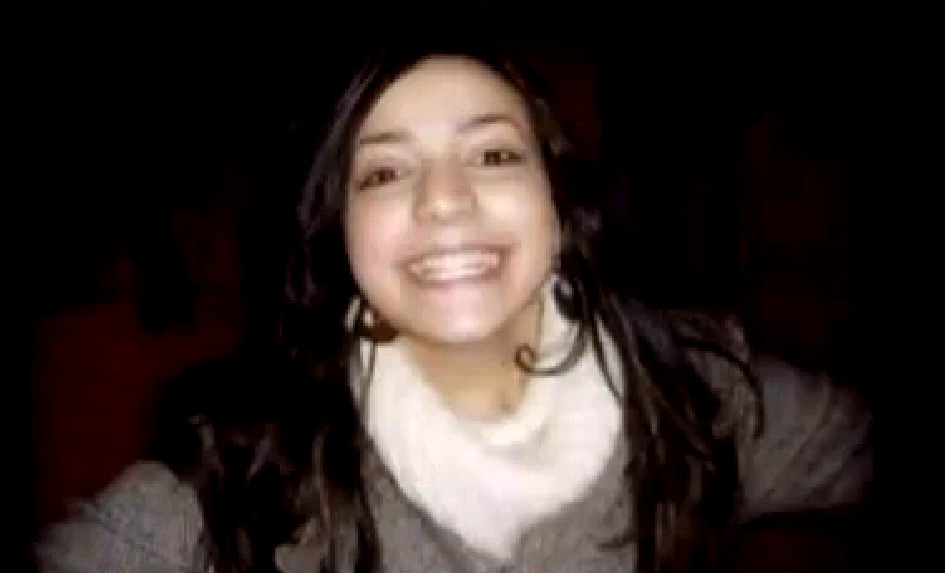
Some of our readers may not have noticed the new link to The Meredith Case Wiki to be found in the left hand column of this front page. I had not noticed it myself until recently.
This is an important link to a new website that is now a vital additional resource for those interested in understanding this case.
The website - The Murder of Meredith Kercher - is run by Edward McCall, with the assistance of other contributors, and TJMK is pleased to acknowledge and promote its distinctive and concise approach to presenting the facts of the case.
The site is modelled on the format of a page from the Wikipedia free encyclopedia. As with a Wiki page it is easily navigable. The data presented under the various headings is the consequence of much research but it still remains a work in progress. Wherever possible the material used is referenced in footnotes.
It starts on the Main page with a Mission Statement and an Introduction to the case. It then considers the evidence and has a good section entitled Myths Debunked.
The reader can easily access significant court documents: the Massei Report, the Hellmann Report, the Galati Appeal and the Supreme Court of Cassation Motivations Report. There is an accessibly summary of the Matteini and Micheli Reports.
In particular, for the researcher, there is a most welcome section entitled Court Transcripts. Here can be found transcripts of witness testimony from the Massei and Hellmann trials, experts reports, and the various writings and testimony of Amanda Knox, Raffaele Sollecito and Rudy Guede. At least that is to be the hope ultimately as there exist a good number of gaps at present.
Already some of the witness statements have been translated from Italian to English but there are a number of transcripts still to be translated. If there are any translators who would wish to help, please contact us and we shall be pleased to put your name forward.
McCall wishes to acknowledge the massive contribution made by True Justice for Meredith Kercher. TJMK has perforce grown organically and exponentially over the years and has accumulated a breadth and wealth of data, in-depth analysis and informed comment on the case which is unsurpassed on the internet, or indeed anywhere.
It will continue to do so and report developments until the conclusion of all aspects of the case.

